Click on any of the talks below or scroll down.
14 December 2016
MINCE PIE DAY
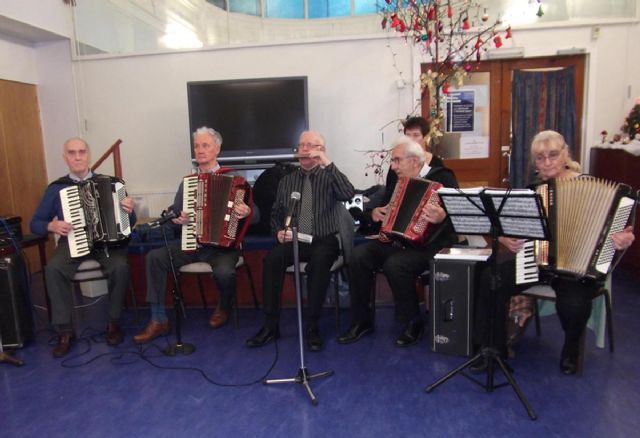
Buttons and Bows
Chairman Bert Oliver welcomed 53 members who proceeded to enjoy their mince pies and coffee together with a good ‘blether’.
The morning’s entertainment for the last meeting of the year was provided by ‘Buttons and Bows’, a group of retired folk who have a wonderful hobby.

Our Compere
They travel around clubs and gatherings in Fife providing music, song and fun all the way. Their mixture of old Scottish tunes was played on the accordions and harmonica and was combined with some fine ballad singing, which certainly hit the spot. It had the Club members humming, tapping their feet and singing with great zip and vigour.
The six entertainers of ‘Buttons and Bows’ were given a great ovation at the conclusion of their performance and Colin Moore gave them a well-deserved vote of thanks.
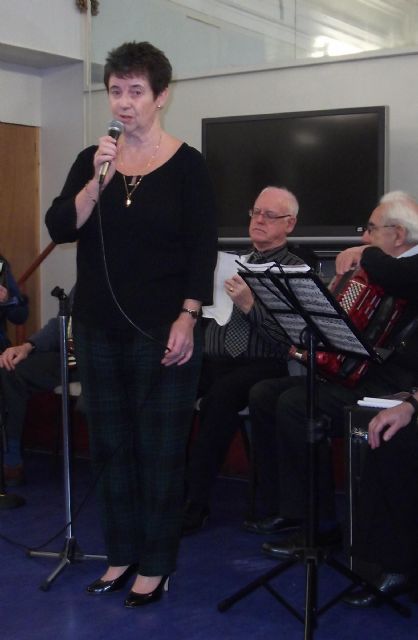
Our soloist
Meeting report by Colin Moore - Photos by Peter Speirs
23 November 2016
NACHTHEXEN
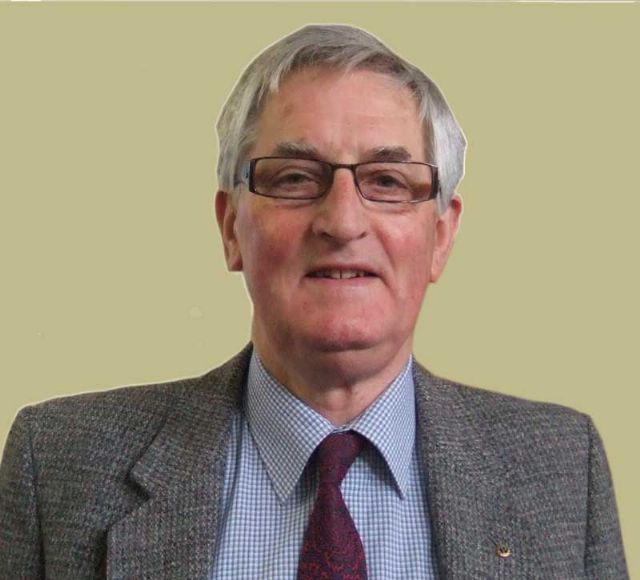
Ron Campbell
Ron’s talk was about Russian female bomber pilots, the Nachthexen, a German word which translates as "Night Witches". These women were formed into a night bomber squadron and flew U2 biplanes with wooden propellers.
Their planes were very simple to operate and service, which made them very effective. They could be serviced and rearmed with bombs in under ten minutes. Some pilots are recorded to have flown as many as eighteen times in one night.
The Germans loathed and feared these women pilots in equal measures. Their planes came down suddenly on a quick descent out of the night sky like witches on broomsticks, hence the German title, "Nachthexen - Night Witches." They were thought to be totally fearless. They are credited with thwarting Hitler's quest for oil in the Caucasus because of their constant harassment.
They fought for Stalin and the Motherland and regarded themselves as ordinary members of the Communist party but certainly did an extraordinary job.
Ron's talk was very well researched, very well illustrated and extremely well presented. Members present had a first rate morning.
Colin Moore gave the well deserved vote of thanks.
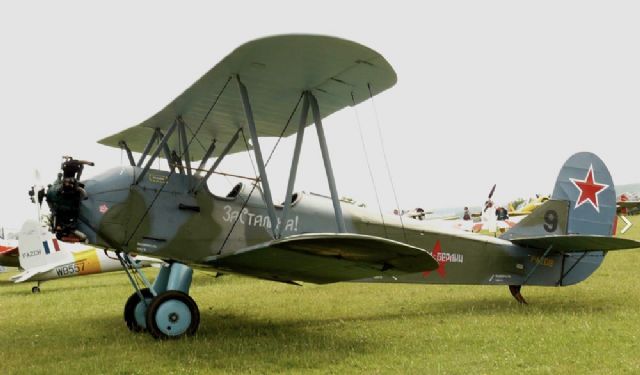
A Polikarpov Po2 biplane
9 November 2016
THAT'S A COINCIDENCE!

Colin Moore, our speaker today, is also Convener of the Speakers' Team
Chairman Bert Oliver introduced one of our own members, Colin Moore, to speak on ‘That’s a Coincidence!’ Colin began by saying that mathematicians maintain there are no such things, but psychoanalysts say that it is the science of serendipity. He then shared some amusing, tragic and inexplicable coincidences, leaving us to make up our own minds.
Fictional author Morgan Robertson wrote ‘The Wreck of the Titan’, 14 years before the Titanic sank, details of both tragedies being identical! Furthermore, Violet Jessop, a stewardess on the SS Olympic and one of the few survivors when it sank, then survived again when working on the Titanic on its fatal journey. In 1916 she was on the SS Brittanic which also sank and she was thereafter known as ‘Violet the Unsinkable’!
And how about 2 assassinated American Presidents – Lincoln elected to Congress, 1846; Kennedy, 1946. Lincoln to President, 1860; Kennedy, 1960. Both shot on a Friday, in the head. Lincoln’s successor Andrew Johnson, born 1808 and Kennedy’s successor Lyndon Johnson, born 1908. Lincoln was shot in the ‘Ford’ Theatre, Kennedy was shot in a ‘Lincoln’ car made by ‘Ford’.
Then we had strangers Neil Douglas and Robert Stirling, "doppel-gangers" or "doubles", who were randomly seated together on a Ryanair flight. With identical faces, beards and hairstyles they later found that they had both booked into the same hotel.
Date – January 1913, location – Cafe Central, Vienna, frequented by Dr. Sigmund Freud who studied and noted customer behaviour. Amazingly, five of the regulars were named Trotsky, Hitler, Stalin, Tito and Lenin!
This was a varied and well-researched piece of entertainment and a real treat to have such an accomplished speaker as Colin who, as a retired headmaster proved that he can still command his audience, young or old!
Colin received a well-deserved vote of thanks and the members expressed their enthusiastic approval.
26 October 2016
THE V&A DUNDEE
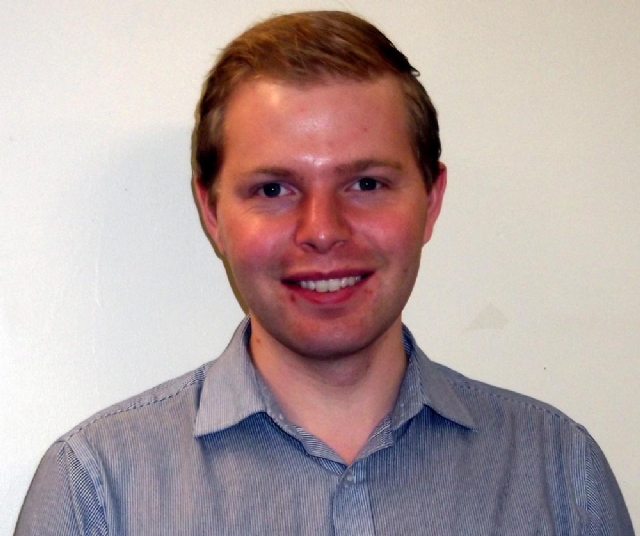
Peter Nurick, part of the Dundee V&A development team, gave members a splendid introduction to the museum which is to open in Dundee in summer 2018, with both images and commentary presented with verve and knowledge. The London V&A Museum of Art and Design was founded in 1852 as a follow-up to the Great Exhibition and now holds two to three million objects. Ten years ago it was looking to expand at the same time as Dundee Council were seeking a flagship project for their riverside development.
This, the third largest urban development in the UK today, aims at restoring the link between the city centre and the Tay. This massive new gallery will be that flagship: though it will look shiplike, its iconic outline is based on the striated formation of east coast cliffs. It must be stressed that the new museum is a partner of the London V&A but quite independent of it; moreover it is a museum of design only.
It can host some of the London V&A’s famous travelling exhibitions like Hollywood Costumes or Alexander McQueen designs. As its national design gallery it will also highlight Scotland’s contribution here with the biggest exhibit being a reassembling of Charles Rennie Mackintosh’s Ingram St. tearoom : 90 feet long, two storeys high, 600 pieces, all brought from storage in Glasgow.
Dundee is the UK’s first UNESCO City of Design and among the exhibits will be D.C. Thomson comics and the products of local computer games producers. There will be a huge entrance hall, suitable for all sorts of gatherings, and a restaurant not only overlooking but jutting out over the firth. The comic strip on the wall now bordering the site not only is possibly the world’s largest comic strip but was the official UK representative at this year’s Milan Design Triennale, the international festival which welcomes half a million visitors. That we can still view if we go up to Dundee and will whet our appetites for the splendours to come in 2018.
This was a first class presentation from Peter Nurick and he deserved the appropriate vote of thanks from David Cleland and the hearty applause from the membership.
12 October 2016
FIFE LIBRARIES
The Chairman welcomed Jennifer Stewart, a Service Development Officer from the Fife Community Trust, to talk about Fife Libraries.
Jennifer explained that the Fife Community Trust was responsible for managing arts, archives, museums, libraries and 4 theatres in Fife. There are 44 libraries in Fife, 5 of which are in shared premises. However the scope of libraries has changed considerably recently – not just books! Although books still predominate with 1.7 million book loans last year.
Apart from static libraries there are mobile libraries, a home delivery service, and special collections to homes. Children can be registered from birth and can participate in a range of activities such as Bookbug activity sessions, author events for children, the popular summer reading challenge, book group for teens and a Facebook link.
There are general reading groups, special events such a ‘reading with gin’ at Eden Mill, and Book Week Scotland with author presentations. An interesting fact is that reading is good for you. Apparently reading for 6 minutes reduces your stress level by two thirds, and is better than music, walking or a relaxing cup of tea. Another healthy activity which has been set up in a few areas is WalkOn, where a short walk of about 40 minutes is followed by a chat about books.
Other activities which have been developed include Moments in Time for dementia sufferers, Book Prescription Service for users with mental health problems and supporting learners with reading difficulties.
WiFi is available in all libraries, as well as computers for general use which are particularly useful for job seekers. In addition, Fife libraries provide an e-service which you can access via the internet. This includes e-books which you can borrow for 3 weeks, e-audio, and a wide range of free magazines in e-magazines.
In addition, there are trained staff in Cupar, Kirkcaldy and Dunfermline to help users find out about their family history. Jennifer ended the talk by answering several questions from the interested audience. Past Chairman John Topliss gave a suitable vote of thanks for her first-class presentation.
28 September 2016
WADE'S HIGHWAY
Speaker Alfie Ingram's talk on “Wade’s Highway” was a fascinating journey along old fashioned roads illustrated by a suitably old fashioned slide projector.
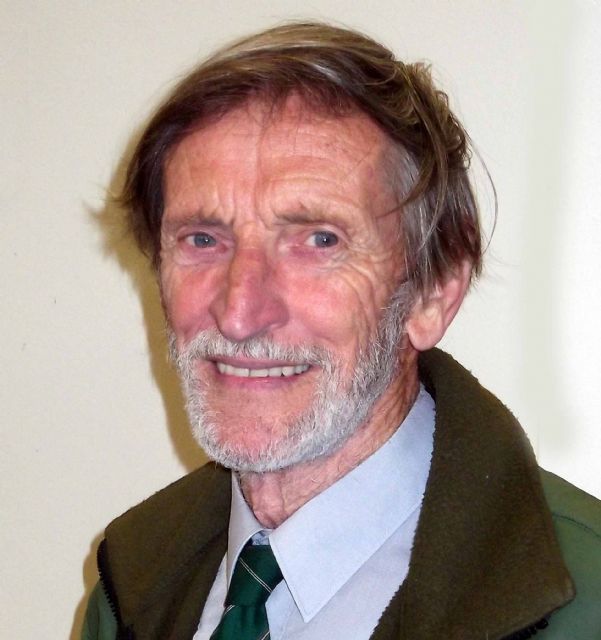
Alfie explained how the lack of any roads in Highland Scotland in the XVIII century hindered defences against Jacobite insurgency and how the ambitious Major-General (later Field-Marshall) George Wade was sent north to set up a policing force & strengthen forts.
This he did : the Black Watch was founded and forts built round historic areas like Inverness or Cromwell’s sites like Fort Augustus. The military needed speedy passage between the forts and so the roads had to be built. The main ones were Fort William to Inverness and Inverness to Dunkeld: like today’s lorries on the A9 beside it, they by-passed the townships. The diggers were soldiers who were paid more and given better food than guards. The bridges were put up by local builders and could be expensive. The one over the Tay at Aberfeldy cost £5,314, 15s, & 10p in 1734, such a huge sum that questions were raised in Parliament. However that bridge still stands today.
Wade is remembered for his roads but in fact he handed this task over to a subordinate in 1732 and most of the so-called “Wade’s roads” were built later under other commanders. By the start of the XIX century other authorities took over road building and the roads went from town to town by-passing the military ways. The latter were sometimes better sited: nowadays when, as regularly happens, landslides block the Rest and Be Thankful, the traffic has to be diverted via the old military road. Most of us know the rhyme about “If you had seen this road before it was made,you would lift up your hands and bless General Wade”. Another less frequently cited poetic tribute is found in the National Anthem: “Lord, grant that Marshal Wade/May by thy mighty aid Victory bring./May he sedition hush and like a torrent rush,/Rebellious Scots to crush./God save the King.” Alfie Ingram’s talk certainly deserved John McManus’ hearty vote of thanks.
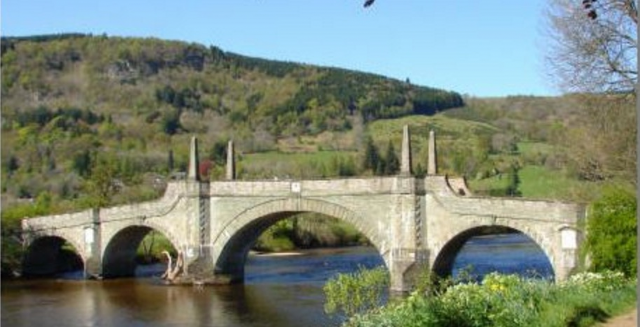
Wade's Bridge at Aberfeldy
14 September 2016
DOING PORRIDGE
Neal Robertson is the owner of Tannochbrae Tearoom. Being 2010 World Champion porridge maker and the inventor of the ‘Spon’ (a double sided wooden mixing spoon) are only a few of his successes.
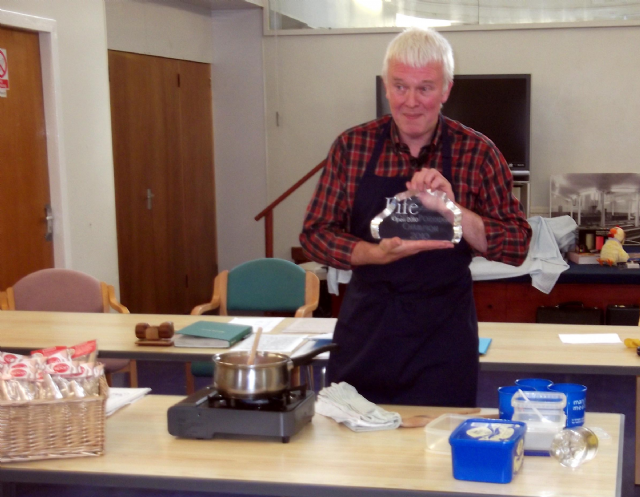
Neal cooked a 'porridge' dish, used by Mary's Meals in Malawi, while giving his talk
Competing with these achievements was his cooking of porridge for Alex Salmond and his cabinet at Bute House, the event now commemorated by the large photograph hanging in the Tannochbrae Tearoom toilets!
Angus Allan rounded off a great morning with a humorous and appropriate vote of thanks
27 July 2016
BEE KEEPING
There was a real buzz around the room as we welcomed our speaker Marion Lang with her subject "Beekeeping". Marion explained that her interest in beekeeping began in her youth while in Kenya. She learned many of her skills from Kenyan natives. Honey was used by the natives to brew "Pombey". This was a very intoxicating alcoholic drink.
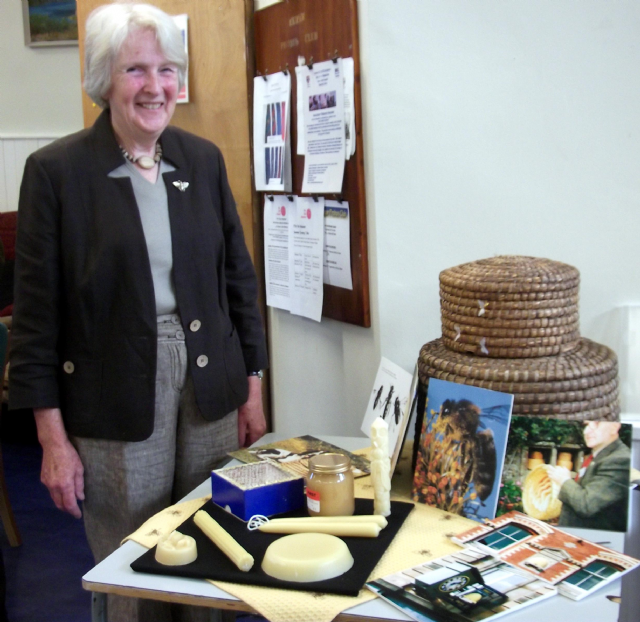
Returning home, she extended her knowledge by attending courses on beekeeping at Elmwood College. She learned more about the anatomy and structure of these amazing creatures. A local bee expert, Marshal Land, became her mentor. He helped her to establish her own hives of bees. She joined the Fife Beekeepers Association and began giving demonstrations and winning awards at shows. She further extended her understanding when meeting other enthusiasts, learning tricks and methods never found in books. She preferred making her own hives and realised that new swarms soon sorted themselves out when given a new home.
Marion went on to serve on the Scottish Beekeepers Executive. Since 2004 they have had an educational side, for example, having a schools tent at the Royal Highland Show. Fife Beekeepers celebrate their 100th Anniversary this year. Marion explained that beekeeping in Scotland can be quite difficult because of the long winters. The recent record of poor summers has led to very low yields.
Beekeeping has also faced difficulties in recent years with the increased rules and regulations from rigid veterinary regulations. A lot of beekeepers have been discouraged by the "red tape" now involved. Marion finished her talk by sharing with club members a fascinating collection of memorabilia. There were photographs, honey, beeswax candles, a hive, and other materials complementing her talk. She emphasised that honey should always be enjoyed with the comb and also provided samples of home made honey tablet which was gratefully consumed by all present. Her excellent talk was followed by a wide range of questions from club members. Marion answered these with great aplomb and expertise. This was a really lovely talk. A well deserved vote of thanks was given by Alex Ness.
13 July 2016
FIFE TRAMCARS
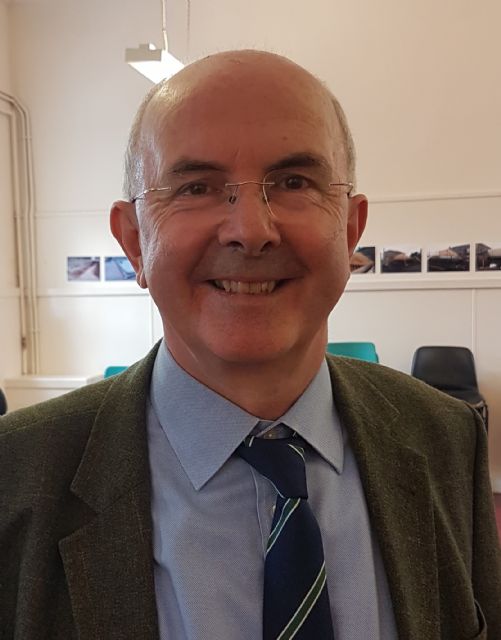
Bert Oliver introduced our speaker Keith Mason, a practising solicitor for the Church of Scotland, to talk about some of the early history of trams in the Fife area.
Keith explained that a tram-train from Glasgow to the airport has been proposed. This would be the next new tram in Scotland.
He started by recounting an episode at Forfar Station when he was about four. The first steam train he had ever seen suddenly let off a lot of steam and frightened him. He was scared of steam trains for a long time after that, but that did not stop him wanting to find out more about trams after seeing the tramlines in the Dundee High Street.
He explained that the original Tramways Act of 1870 lasted until 1992 when it was updated. Trams were originally horse drawn, but they could be powered by steam, cable, or electricity. Edinburgh had cable-powered trams until the 1920s.
Kirkcaldy wanted trams early on but they didn’t have a power station. Eventually one was built in 1902 at the corner of Dunnikier Road and Victoria Road and the trams were soon operating. The building is still there. Dunfermline followed with a power station and trams in 1907. Keith showed many interesting old photos of trams in Kirkcaldy, Cowdenbeath tram depot, and Dunfermline.
A feature of the pre-WW1 photos was the absence of cars and people. However he noted the postcard shops in every town. That was when people could send a postcard in the morning and it would be received the same day. Subsequently a new line to Leven went through private land provided by the Wemyss family and had fast American tramcars. These had yellow livery and were called “Mustard Boxes”. Dunfermline, however, was never connected through Kirkcaldy to Leven.
The last tram in Kirkcaldy ran in 1931. Restored trams can be seen at several tram museums in the UK. Interestingly, a restored “Wemyss” tram can be seen running on a heritage line in Sintra, Portugal. This fascinating talk ended with many questions from the members and the vote of thanks was given by Mike Edwards, a self-declared tram enthusiast.
Report John Topliss and photo Peter Speirs
22 June 2016
KNIGHTS TEMPLAR
Malcolm Walker
The Chairman welcomed Malcolm Walker, from Raith Probus Club, who gave a fascinating talk on the history and myths of the Knights Templar.
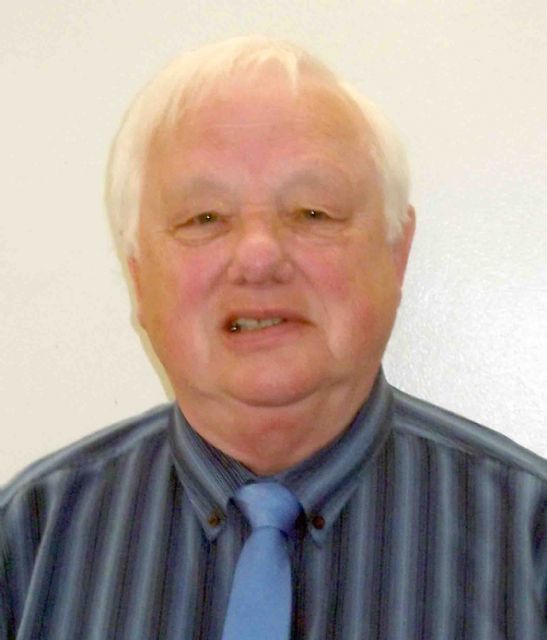
Malcolm explained that the Templars were formed about 1199 by Hugues de Payens at the request of Pope Urban 2nd who was concerned with the rise of Muslim power in the middle east. At that time the Crusaders had acquired much land in that area and needed military support.
The original Templars were 9 nobles, who were probably related. Their role was to safeguard churches in the Holy Land, and they were identified by a special red cross on a white cloak. Their numbers grew rapidly and were known for being skilled fighters in the Crusades. They became answerable only to the Pope and the Grand Master, wielded considerable power and move freely through the Christian countries. They were not taxed but could raise taxes on their own lands.
However the rise of Saladin and the new dawn of Muslim power led to disastrous losses for the Templars and Crusaders in key battles from 1187 onwards culminating in Saladin taking Jerusalem, the Templars headquarters. It was won back but eventually fell permanently into Muslim hands in 1244. After that, support for the Templars waned over a long period. King Philip IV of France, in connivance with the Pope, arrested the remaining ones for trial in 1307 and had them burnt at the stake on trumped up charges to clear debts. The Pope then disbanded the Templars in 1312.
From the questions that followed the talk it transpired that most of the modern direct associations with the Templars are myths, although the name Temple is still used today in places where Templars had known buildings, e.g. Temple Bar in London.
The vote of thanks was given by Douglas Provan.
Report John Topliss. Photo Peter Speirs
8 June 2016
MY JUTE JOURNEYS
Sandra Thomson
The Chairman then introduced Sandra Thomson, our speaker for the day. From the very beginning, Sandra Thomson enthralled us with a mix of humour and information on today’s subject “My Jute Journeys.”
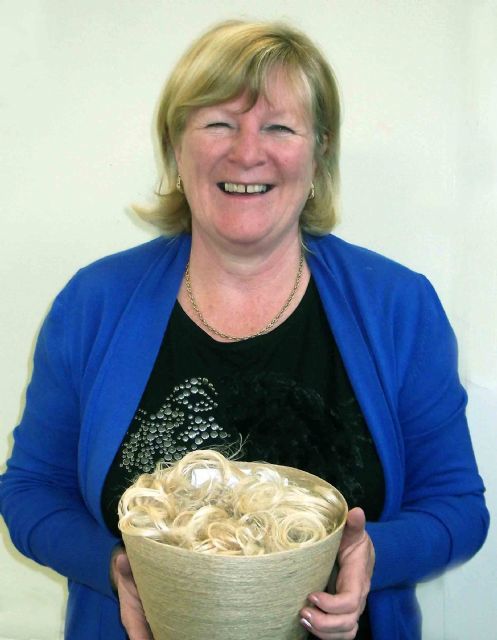
Sandra with some jute fibre in a jute basket
Working without notes Sandra led us from 800BC when Jute was first used as a soup and medicine leading us to Dundee where massive employment was created from the “Chapper-uppers” to the bairns used mainly to work under the machines with considerable life threatening danger to themselves. Dundee benefited from all the skills required for this industry from engineering to weaving and being imported in all different shades, white jute being the best.
We heard of the continual fire risk and extreme working conditions with an average lifespan of 38. Sandra then journeyed with us to Calcutta; it’s heat, it’s odours and its complete lack of modern amenities but she was adamant in her love of the workers and Calcutta became a regular and happy place to be. To end, we were shown several jute items, flower pots, hats, compressed jute for making coffins, even a pair of men’s shorts!
Sandra Thomson excelled in her subject and after questions David Nimmo gave a vote of thanks expressing our appreciation.
Report Bert Oliver. Photo Peter Speirs
25 May 2016
TV TIMES
Andy Paterson
The Chairman welcomed back to Cupar Probus, speaker Andy Paterson, whose “TV Times” today was a follow-up to his most enjoyable talk on ‘’Stars of the Silver Screen’’ in which Probus members had to identify stars and titles from past decades.
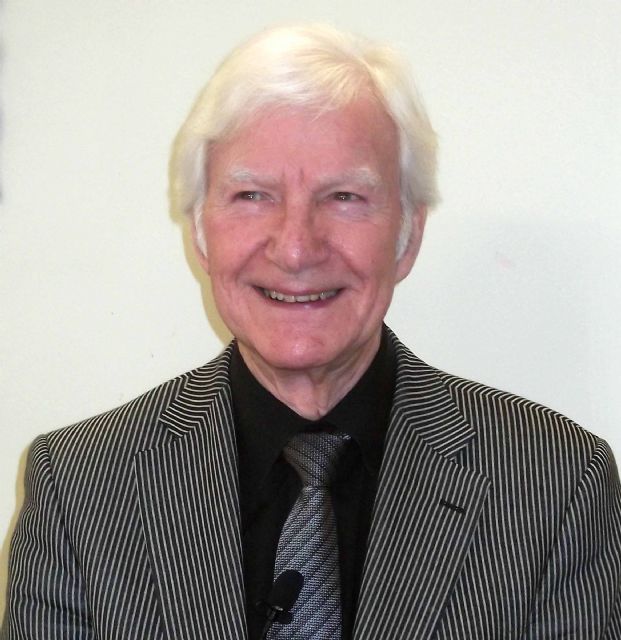
Starting with the nine inch screen embedded in handsome wooden furniture that appeared in many households after the televising of the Coronation in 1953, he produced image after image of TV stars and their programmes.
All genres were there: panel games, comedies, westerns, hospitals, variety, ads, and our members’ memories were well tested. It turned out most of us could recall past actors and their roles quicker than what we did last week: we could even sing along to jingles (“The Esso sign means happy motoring”).
We learnt about the stars’ subsequent lives when success left them; we saw images of a young Joanna Lumley as Heidi or of the Osmonds’ first appearance, in an Andy Williams show, or Clint Eastwood’s début in Rawhide. Not much appeared later than Fawlty Towers or Dad’s Army: we all agreed with the speaker that his fascinating trawl of programmes proved that today’s TV cannot hold a candle to that of past decades.
Bob Farmer gave the vote of thanks for Andy’s really entertaining presentation on the TV stars of the past.
11 May 2016
THE LEWIS CHESSMEN
David Caldwell
Chairman Bert Oliver welcomed our speaker Dr. David Caldwell who recently retired after a distinguished career as curator with the National Museums of Scotland. David gave us a thoughtful and thought provoking presentation on one of his specialist subjects, "The Lewis Chessmen".
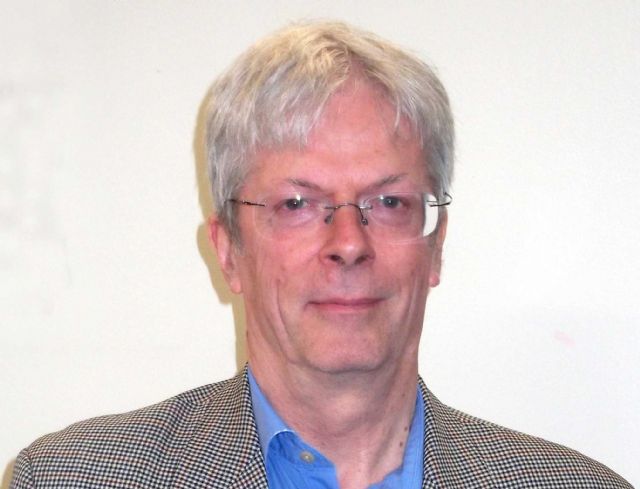
David explained that these objects are world renowned. They have mysterious origins. Their unique design and curious, almost comical expressions,range from moody kings to a frightened looking pair of wardens biting down on their shields. David has done a lot of ground breaking research on the chessmen. He took us through his findings by asking a lot of thought provoking questions and providing possible solutions and theories as answers.
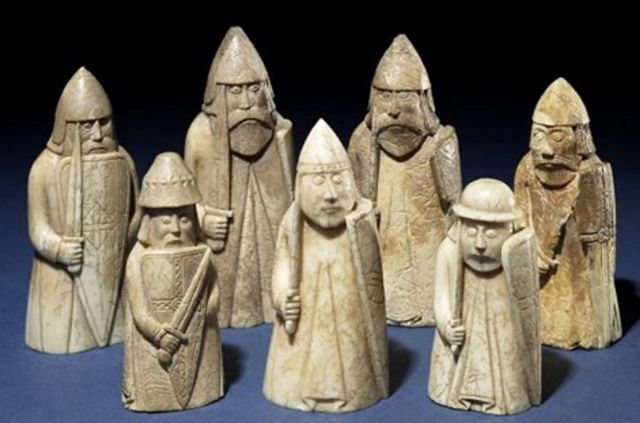
A few of the chessmen
He covered everything from the story behind their enchanting expressions to a new theory suggesting when and where on Lewis they were found. He explained that the Isle of Lewis was a "central hub" in those days essential to Scandinavian sailing routes. Merchant traders regularly passed through the island. We learned that the chess pieces were individually hand carved, mainly from walrus ivory. They were most likely made by five different craftsmen.
The standard of work is variable and could have been made by a workshop under pressure.
David used the chessmen as a time portal transporting us back into history during his fascinating talk and after an interesting question time, a well deserved vote of thanks was given by Ron Campbell.
27 April 2016
THE PRESTON BANK FRAUD
Martin Hepworth
The speaker this week was Dr Martin Hepworth, who gave us a most entertaining and thought provoking talk on the Preston Bank Fraud of 1883.
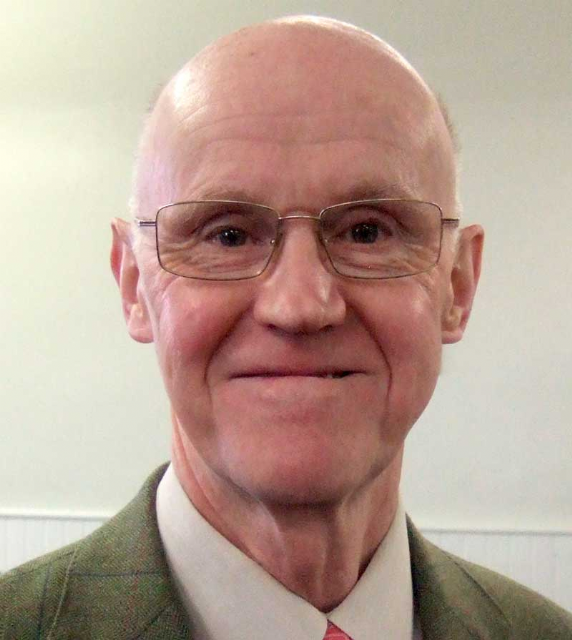
The fraud was uncovered during a visit by the auditors, when £2,000 was missing – a large sum in today’s values. The Bank’s Sub Manager had disappeared and a warrant was issued for his arrest. He was found fairly quickly, but in New York and then the real problems started.
Dr Hepworth’s talk took in the problems of extradition and the varying laws in England and the USA, and also mentioned the great City of Glasgow Bank Crash, which happened at around the same time.
The talk was much enjoyed by members and parallels were drawn with current events in today’s financial world.
Probus Chairman, Bert Oliver, thanked Dr Hepworth and announced that this had been his fourth talk to the Club – a record of excellence for which the Club is very grateful.
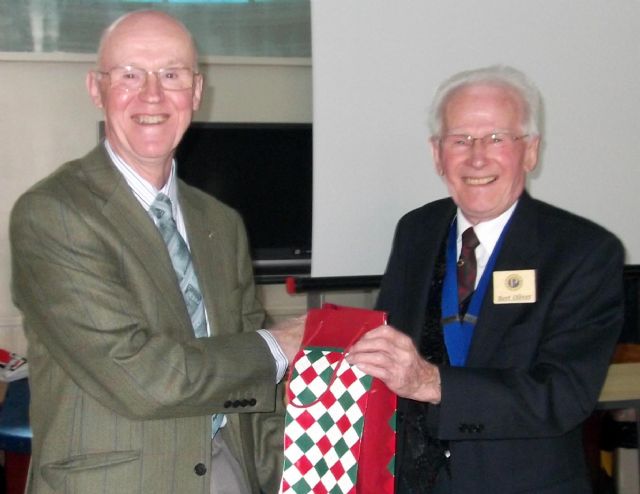
Dr Martin Hepworth was given a gift by Chairman Bert Oliver to mark his fourth talk to Cupar Probus Club
13 April 2016
KEEP MORPHOLOGY ALIVE
Michael Mulford
The speaker for today, was Michael Mulford. His talk was on "Morphology", which he defined as the love of words and phrases, their use and misuse.
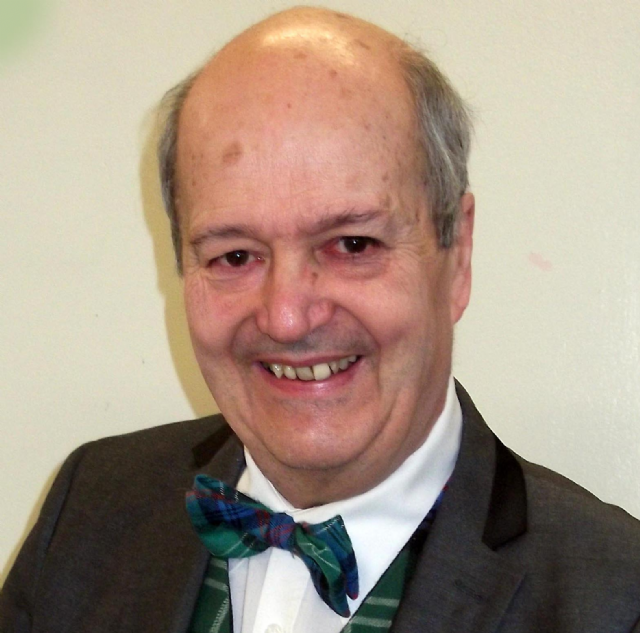
Michael Mulford
Michael called on many examples from his distinguished career in newspapers, broadcasting and government public relations. He also told us that all the events in his talk were true, but he emphasised that he never let facts get in the way of a good story!
He had club members rocking with laughter from the start of his talk when he related the errors made when he was a young trainee on the Courier newspaper. He then kept the laughter bubbling along by sharing some of the comical moments he encountered during his long and varied career.
Michael often 'interrupted' his own talk with hilarious news flashes which always left the audience laughing uproariously.
He told of the difficulties and unfortunate errors made when translating dialect in various parts of Scotland and the amusing ways these were recorded in the press. He concluded with his work at STV, telling us about some of the hilarious misuse of words made by newsreaders and continuity announcers.
Michael provided us with a show stopping performance from start to finish. He was a most amusing and entertaining speaker and earned a well deserved ovation at the end of his talk from the members present at the meeting.
Robin Thompson concluded the meeting by giving our speaker an excellent and well deserved vote of thanks.
23 March 2016
R.L.STEVENSON
David Reid
Today’s speaker was David Reid, a retired headmaster and English teacher, who gave an incisive talk on Robert Louis Stevenson.
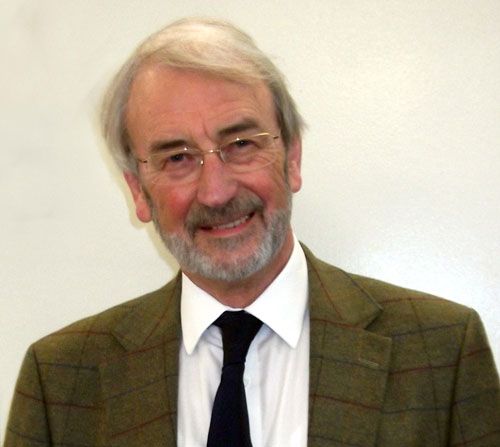
David Reid
Of the great Scottish trio of internationally renowned authors, Burns, Scott and Stevenson, he is the most read in the world : of all Scots writers only Conan Doyle has more readers.
Stevenson founded the psychological novel with Dr Jekyll and Mr Hyde but his other works contain contrasts as well, either between leading figures like Alan Breck and David Balfour in Kidnapped or within characters like Long John Silver or the Laird of Ballantrae where admirable and detestable traits mix.
These reflect divisions within Stevenson’s own life : the blockbuster author who had studied civil engineering and the law and was the inhabitant of both Victorian Edinburghs, the douce and sophisticated New Town and the raucous and immoral Old Town.
Though the ill health which led to his death at 44 forced him to travel furth of Scotland and finally to Samoa, he still always remembered his native land, which is perhaps only just beginning to honour him as it should.
As well as demonstrating Stevenson’s skill at both characterization and dialogue, Mr Reid also delighted his audience with a broad Scots extract from the tale “Thrawn Janet”. T.S.Eliot once wrote of a critic that after reading his introduction to an author, then reading that author “was the only pleasure in life”.
Mr Reid will have rekindled that enthusiasm among members of Probus, who will be hurrying to their libraries to renew acquaintance with a writer they may well not have looked at since their boyhood.
9 March 2016
SCOTT'S PORAGE OATS
Duncan Lowe
Today’s speaker was Duncan Lowe from Uthrogle Mill who gave a fascinating talk on both Scott’s Porage Oats itself and the important and growing role it plays within the PepsiCo food empire.
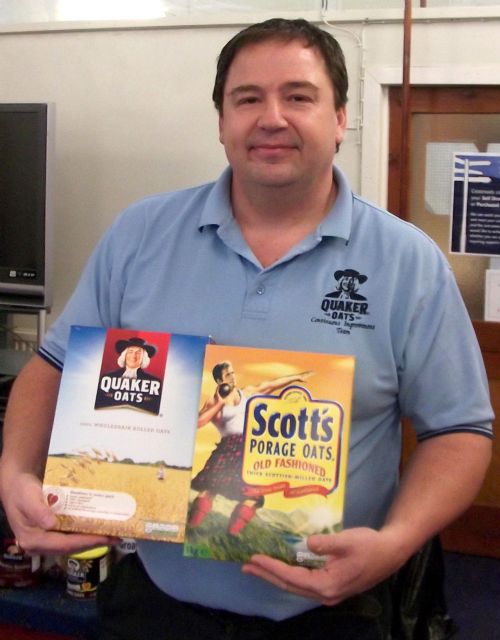
Duncan showing Quaker and Scott's brand products
The Scott brothers set up the first mills in Glasgow in 1880, moving to Edinburgh during 1884: their famous symbol of the Highlander putting the shot was copyrighted in 1924. In 1947 the company moved to its site outside Cupar.
Thereafter it was taken over by various companies including Quaker Oats in 1982 and along with them PepsiCo in 2001. Since then £50m have been invested in the site and the staff has grown from 90 to 258 in ten years, despite the kind of mechanization that can e.g. pack two million sachets per week.
It is the biggest employer in N.E. Fife and one of the top ten employers in the county. 50% of the oats are grown in Scotland and the products are exported to Europe and beyond.
Though only forming 4% of PepsiCo, Quaker and Scott’s oats form one of its most profitable sectors. The vote of thanks was given by Club Treasurer Peter Speirs who pointed out for once all the audience were involved in a speaker’s topic as we all ate Porridge for breakfast at some time.
24 February 2016
FAIR TRADE IN SRI LANKA
Margaret Lawrence
The subject today was "Fair Trade in Sri Lanka" and the presentation was given by Margaret Lawrence. Margaret began by informing the members she had spent her working life teaching young children but this was her first talk before gentlemen of a certain age!
Her story began by describing the flag of Sri Lanka in detail, the highlands of the area, the elephants and spices.
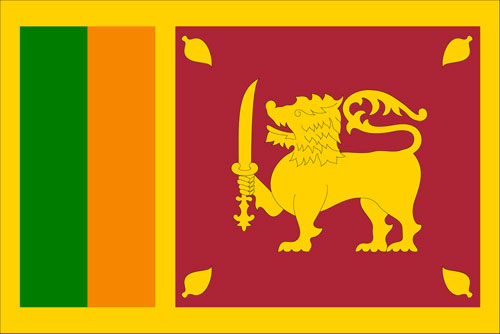
Margaret spoke of the 2004 Tsunami and its utter devastation but the way their life went forward to rebuild their houses and buildings, the 30 year civil war and its end in 2009.
We then heard of Fair Trade and how it works, dealing mainly with Coir, (coconut husk), Fabrics, Tea from plantations and Gospel House where Wooden Toys are made. On the subject of weaving, Margaret (her mother was a weaver in Dundee) burst into song with “The Weavers Song.”
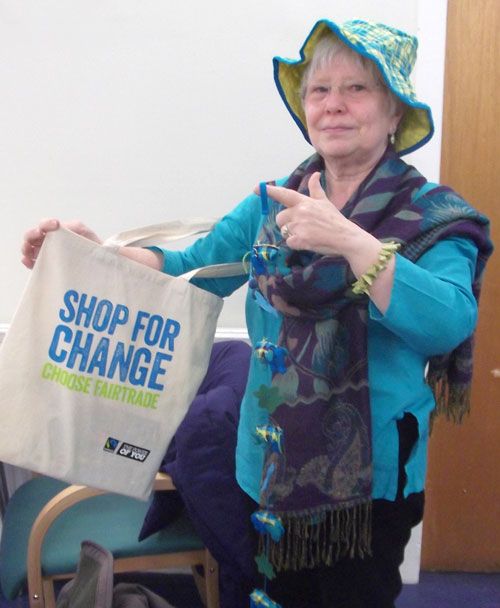
Margaret looking resplendent in some of the Fairtrade items that she brought along.
Onwards to the extensive recycling programme where nothing is wasted and all profits go back into the trades. Because of the better working conditions and education for children, people are now living longer in Sri Lanka.
Margaret inspired us with her enthusiasm for her subject. The vote of thanks was given by Past Chairman Robert McCririck.
10 February 2016
SIGN LANGUAGE
Debbie Dougal
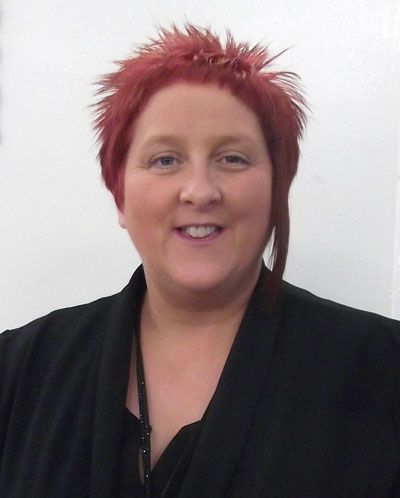
Our speaker today was Debbie Dougall, a sign language interpreter from Fife Council's Deaf Communication Service.
Initially there was some confusion about how Debbie was going to do this because she was only using sign language and appeared not to be able to lip-read. She had given out forms in different languages and indicated that everyone should sign them.
Then to everyone's surprise she suddenly started to speak and it became clear that the confusion was a demonstration of the difficulty of communicating for deaf people. Debbie explained that the British Sign Language is structured differently from the English language and there is not a one-for-one translation between a sign and an English word. Also there are different signs for different accents and dialects, and often different signs for the same word, for example the word 'purple' has 75 different signs.
A trained sign language interpreter has to be able to learn and recognise all the variations, and can tell which religion or deaf school the person has been to. Debbie explained that because of the communication problems there is effectively a deaf world and a hearing world. Many deaf people cannot read English easily or get the grammar right. This becomes a problem at hospital or at the doctor because they cannot understand the instructions on the medication. Also someone who has been deaf from birth will probably not be able to lip-read.
There can be discrimination at work because employers may not be prepared to pay for a sign language interpreter in job interviews. Debbie said it took over 9 years training to become a registered sign language interpreter. She is the only interpreter in Fife for 900 deaf people, and there are only 70 registered interpreters in Scotland. Interpreters can be involved in signing legal contracts, operating theatres, police drug raids, medical appointments, etc. It was noted that the signing on the BBC news bulletins was in English and not easily read in Scotland.
After a busy question time, Debbie revealed that the forms signed at the beginning of the meeting allowed her to empty everyone's bank account and gain access to their health records! Thus demonstrating how easy it can be for poor communication to be exploited. Debbie is an excellent communicator, and presented her important message in an engaging and witty way.
Archie Watson gave a suitable vote of thanks which he completed with a signed thank you message.
27 January 2016
MONEY & LEGAL MATTERS
Irene Martin
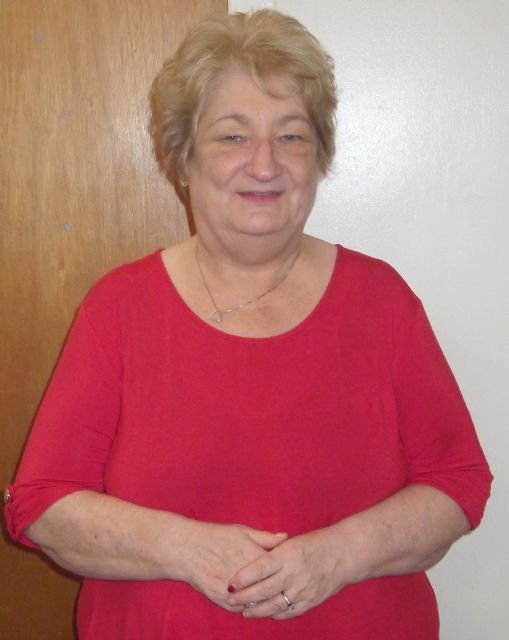
Our speaker today was Irene Martin, Co-ordinator of the Citizen’s Advice Bureau in Cupar.
Her subject was ‘Money and Legal Matters’ and she began with a general introduction of the Bureau telling us how it had started during World War Two, with volunteers helping write letters to loved ones overseas.
This gradually developed into the massive organisation which we have today. She explained that the Bureau is now known as the ‘fourth emergency service’ and is run with a mixture of paid staff and volunteers without which the service could not run.
Irene talked about the wide range of money and legal issues impacting on people today and told us that debt difficulties were now endemic, affecting all levels of society. There was now a Money Advice Unit run by the Bureau which has been established to advise on debt, benefits, bankruptcy, trust deeds and wills. It can help people with gaining power of attorney and help monitor its administration.
Pension credits, attendance allowances and means testing were all highlighted during the talk with money advice now at the core of the Bureau’s work.
Irene is an impressive speaker and talked to the members in a calm and reassuring manner – very experienced, having served with the Bureau for many years. She supplied a wide range of leaflets and booklets on the theme of money and legal matters for club members’ perusal.
25 November 2015
ALEXANDER BERRY
Ian Copland
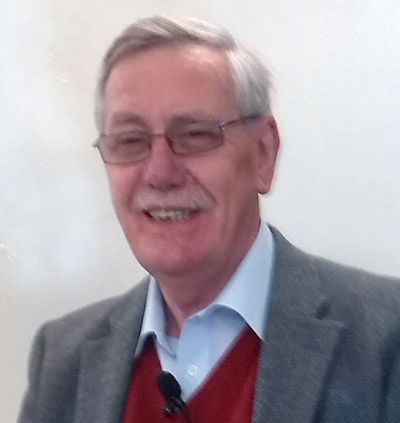
Subtitled “An Aussie Son of Cupar,” Ian Copland described in detail the life of Alexander Berry (1781-1873) from his early life as a boy on Hill of Tarvit Mains, eldest of seven, his first schooling at Cupar Burgh School: his studies at St Andrews University in medicine leading him to qualify as a ships surgeon and onward to world travel.
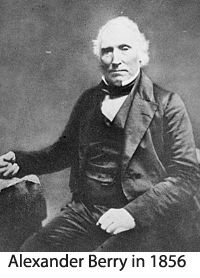
His successful move into commerce led him to Australia, the purchase, development and leasing of land quickly followed with the creation of thriving settlements.
Alexander Berry was a power-house throughout his life, achieving vast wealth but becoming highly respected because of his good works. He bequeathed money to St Andrews University and a hospital in Australia and is memorialised with a statue there.
Ian Copland closed his presentation by pointing out that there was no memorial to this native of Cupar. Some ideas were presented by our members. After questions a vote of thanks was given by Past Chairman John Topliss.
11 November 2015
"TATTIES"
John Marshall
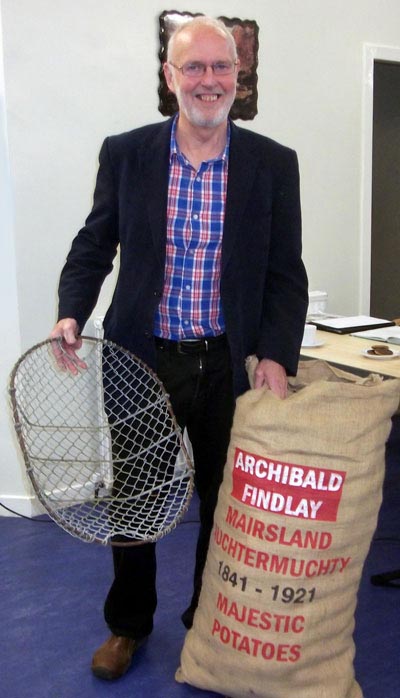
Our speaker today was John Marshall and his subject “Tatties.”
In his many years with the Potato Marketing Board, John proved to be a lively, energetic enthusiast on his subject.
With the assistance of a vast array of screened photographs John led us from his war years on the farm, the history of the Marketing Board and onwards to his world travels as he researched the history and development of potato varieties and diseases.
The humble potato gained a higher status with John’s presentation and ended with Chelsea Flower Show as well as the modern manner potatoes must be supplied to our supermarkets.
A most interesting subject and followed by a healthy question time.
Professor John McManus gave a suitable vote of thanks.

28 October 2015
CUPAR OLD TOWN
Paula Martin
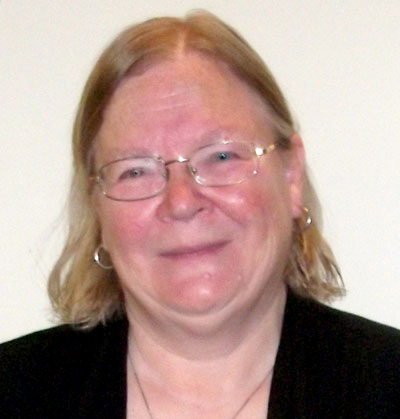
Dr Paula Martin was our speaker today, her subject being ‘Cupar Old Town.’
This was no ordinary tour but a complete history stretching back to the 14th century and building a picture as the town developed.
Within her presentation, Paula treated us to mini histories of Cupar’s Churches, Schools, Inns & Hotels, even our prison!
Present day street names were explained and with the use of photographs and maps we could see how streets and dwellings were altered to suit the expanding population.
We are indebted to Paula Martin for the volume of information she imparted and the insight into Cupar as it was.
Peter Speirs gave an excellent vote of thanks.
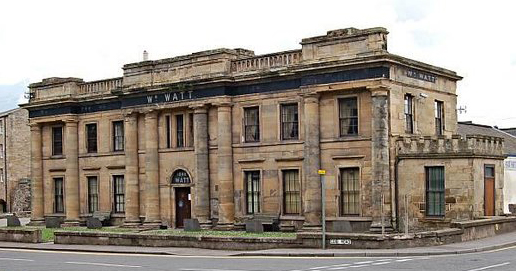
This fine building was originally Cupar Jail
14 October 2015
THE TRANS-ATLANTIC CABLE
Colin Vincent
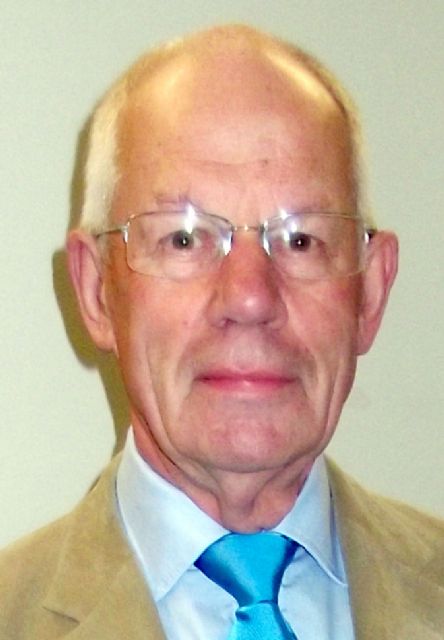
Colin Vincent was our speaker today to inform us about communication over distance.
The Transatlantic Cable. Colin caused us to think about ancient ways man used to send messages of approaching danger, of good or bad news. Fires, beacons, straw bales, runners, horses, all leading eventually to early forms of semaphore and morse.

The early use of electric batteries (like that shown to us by Colin, on the right) led us forward with cable attached to railway lines but when underwater was attempted, this gave way to serious problems of insulation and the sheer weight of a cable being laid on the ocean floor.
As in many great inventions, “Cometh the hour, cometh the man” and names such as Wheatsone, Cook, Lord Kelvin etc became leaders who carried us forward.
Colin Vincent led us through this very interesting subject in a relaxed and easy manner using photographs, sea charts and maps and we are indebted to him.
Maurice Shepherd gave an excellent vote of thanks and our members demonstrated their appreciation.
23 September 2015
THE WORK OF THE WEAVERS
Ron Scrimgeour
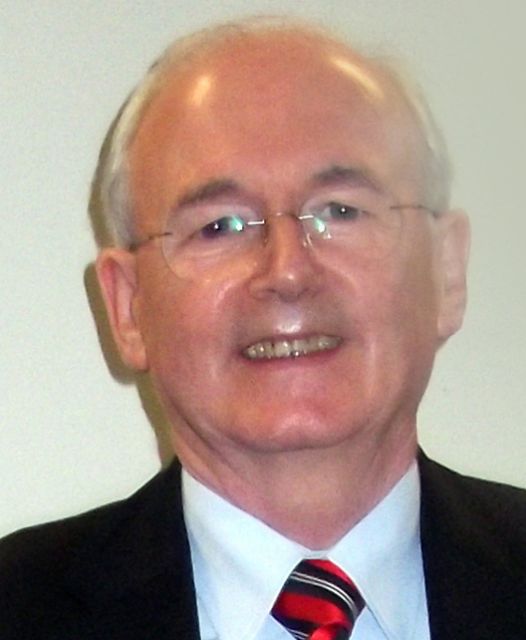
Although Ron Scrimgeour’s talk today was entitled “The Work o’ the Weavers,” it quickly became obvious it was to be much more than its title.
This was a full history of an industrial city stretching back in time to the 16th century, the growing of flax locally, vital to the weavers because of its linseed oil content and on to the import of Jute from Bengal.
Cloth was produced for industry in vast amounts including sand-bags during wars, sails for many well-known ships, for holding various foods, working clothes.
The presentation was nicely mixed with humour and anecdotes of his past and we are indebted to Ron Scrimgeour for his excellent presentation.
After several questions, Bert Oliver gave the vote of thanks.
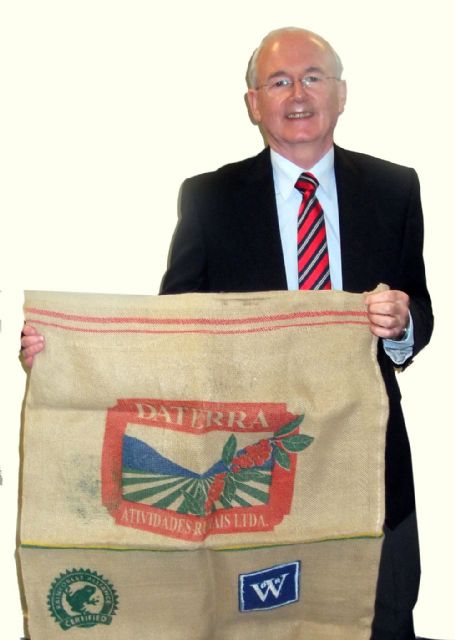
Ron showed a modern day 'jute' bag, made from polypropylene
9 September 2015
WEATHER FORECASTING
Alan Motion
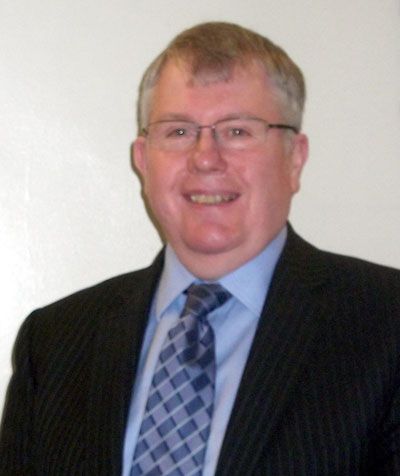
Weather forecasting was today’s presentation by Alan Motion and we were quickly made aware of the vast amounts of data gathered constantly worldwide by the Met Office.
Costing over £190 million to run, employing 1800 people, headquarters in Exeter and 60 sites worldwide, ever increasing use is made of satellite and computer all helping to create a more accurate and detailed forecast to our benefit.
Four million forecasts per day can be produced supplying the different needs of Army, Air Force, shipping, road transport, agriculture and leisure activities.
From the earliest days of forecasting in 1854 to the first computer and onwards to the very latest soon to be installed, our sincere thanks must go to Alan Motion for the amount of information he imparted.
After questions, Secretary David Galloway gave a vote of thanks.
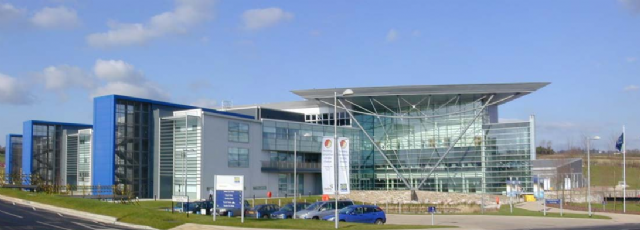
The present Met Office near Exeter
26 August 2015
SONS OF LARGO
Paul Taylor
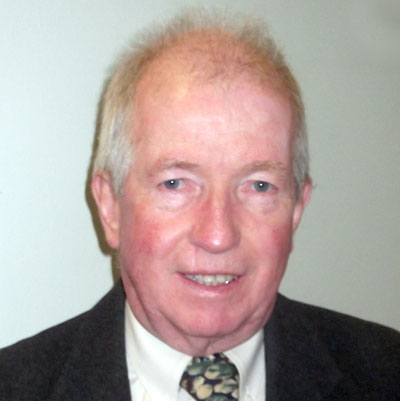
“Sons of Largo” was Paul Taylor’s presentation today. With the use of an excellent display of pictures and maps we toured upper and lower Largo hearing of Sir Andrew Wood, born during the mid-15th Century, a sea Captain who ended as Lord High Admiral before his death in 1515.
We heard of David Gillies, net maker in Lower Largo and his success in this trade as well as caring for his workers, this leading to a short history of the fishing industry within the area.
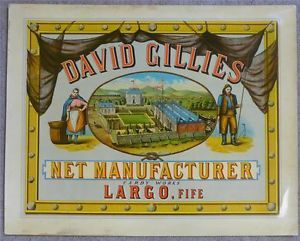
No story with such a title would be complete without the name Alexander Selkirk, marooned on an uninhabited island for over four years giving rise to Daniel Defoe’s fictional character Robinson Crusoe.
Statue of Robinson Crusoe in Lower Largo
-->We are grateful to Paul Taylor for the volume of information he presented within the time available and Chairman David Cleland gave a well-earned vote of thanks.
12 August 2015
DIABETES
Hazel York
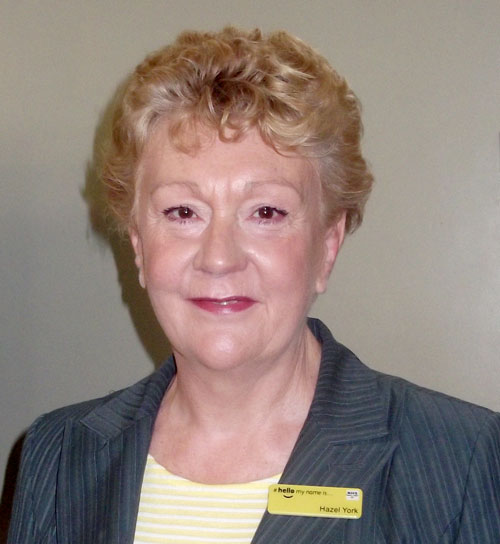
Our speaker today was Hazel York and her subject was Diabetes.
Hazel began by informing us of her medical career and her strong leanings towards this illness.
In a very easy and relaxed presentation we were led through the history of Diabetes dating back to the 2nd Century and the various symptoms to be aware of, as well as the average age when it can manifest itself.
Hazel went on to describe the differences between Diabetes type 1 and 2, the complications that can come from the illness if not treated properly and advice taken,
A very healthy question time followed demonstrating the interest taken in this subject.
Malcolm Truesdale gave an excellent vote of thanks.
22 July 2015
AIRFIELDS OF FIFE
Brian Murray
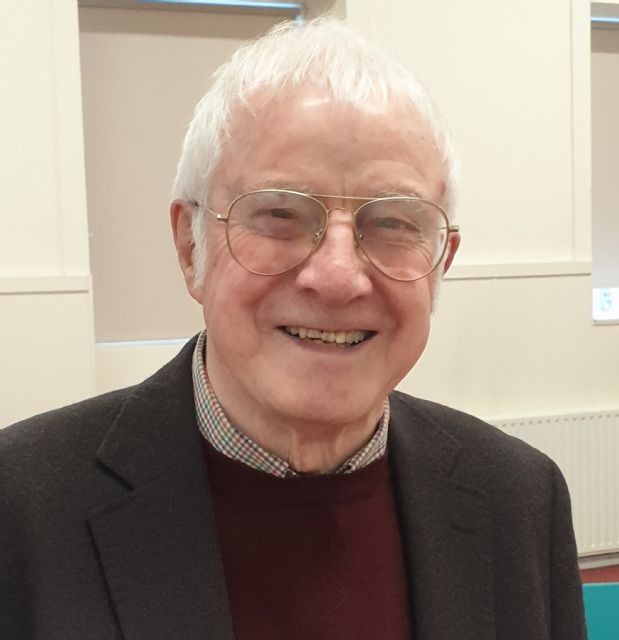
“Airfields of Fife” was the subject of today’s speaker Mr Brian Murray.
We were introduced to the early days of flight with its obvious dangers as pilots and designers embraced a new way of life, on into WW1 when certain aircraft became tried and trusted while others were found wanting.
Aerial photography demonstrated where 15 airfields were sighted during the following years, most of which are no longer in existence. Woodhaven, Donibristle, Glenrothes, Leuchars, with Crail recognised as the best preserved WW2 airfield.
Brian Murray mixed his talk liberally with anecdotes of his working life and the talk ended with several members adding their own thoughts and experiences.
We are grateful to our speaker for showing us areas of Fife we pass regularly without being aware of their history.
Ron Campbell gave a vote of thanks.
8 July 2015
100 YEARS OF SCOTTS
Hilda Scott
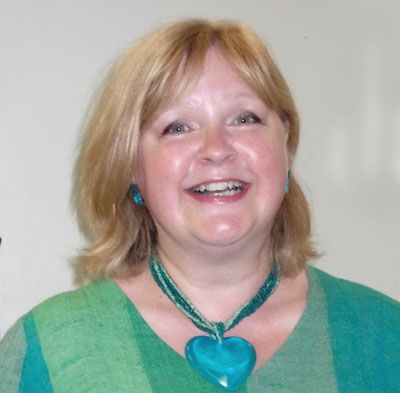
Today’s talk, '100 years of Scotts' (our local ladies clothes shop) seemed somewhat unlikely for a group of 45 men but speaker Hilda Scott with humour, interest and PowerPoint display was able to hold the attention of our members.
We saw the fashions for men and women during the early 20th Century, how styles changed as years passed. The Company takes pride in their complete history in paper, pictures and cuttings.
Hilda Scott spoke of the grim times of fire, flood and war years and why the decision was taken to trading in men’s clothing during the 1990’s. A nicely planned presentation of this well-respected Cupar store since its opening by James A Scott in 1907.
Speakers' Convener Colin Moore gave an excellent vote of thanks.
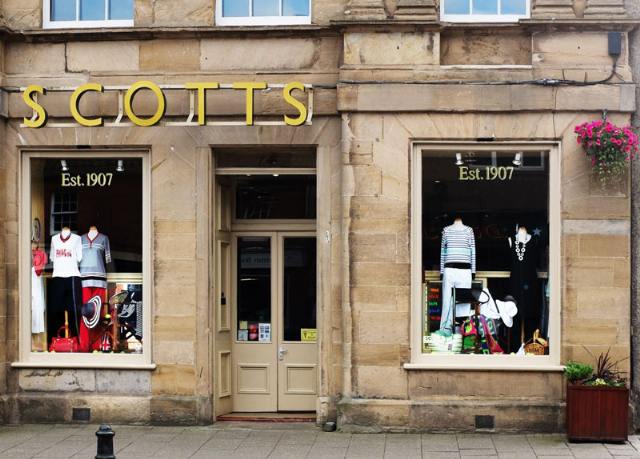
Scotts today
24 June 2015
KETTLE PRODUCE
James McGeehan
Our speaker today was James McGeechan, from the local company Kettle Produce. The facts and figures of this very successful company are difficult to imagine.
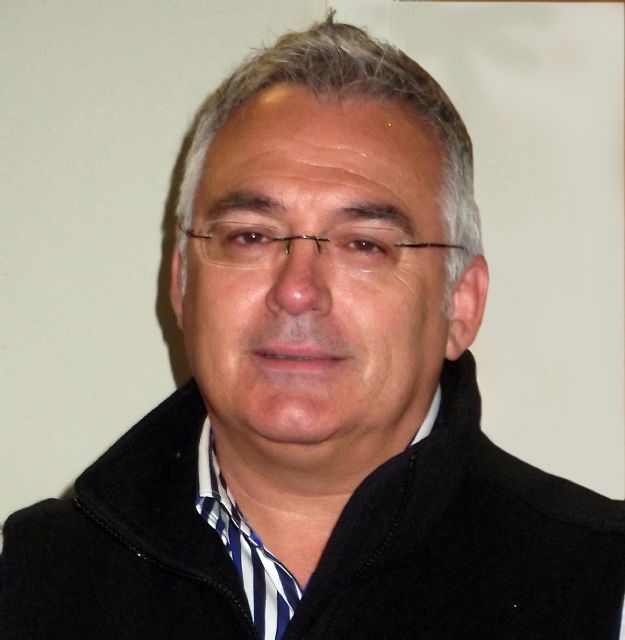
Supplies come from local areas as well as England, Jersey and Spain, up to 90 different products, a varying staff of 900, 18 trucks leaving Fife each day delivering to Tesco, Marks & Spencers, Sainsbury etc. It is very difficult to imagine 80 million kg of carrots, 7 million kg Broccoli as their annual output unless you find yourself stuck behind one of their tractor/trailers travelling at 7mph!
During 2013 Kettle Produce achieved a turnover of £100 million giving an idea of their responsibility to the supply of fresh vegetables to our tables.
On this occasion, question time was a marathon but well handled by James McGeechan.
Bert Oliver gave a vote of thanks.
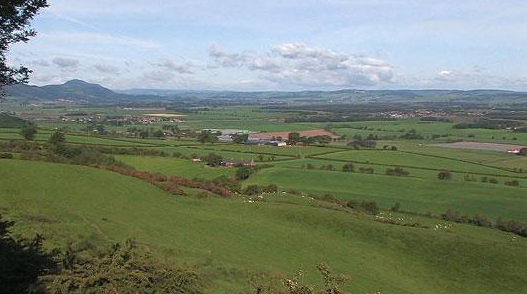
10 June 2015
MORGAN CARS
Laurence Low
Our speaker today was Laurence Lowe, an enthusiast on the Morgan Sports Car.
From its early beginnings in 1910 by Henry F S Morgan, the aim was for perfection only achievable by being handmade. We heard of early use of a three-wheeled car with a large external engine and the later move to four wheels.

The Morgan is created by fitting parts from eight other cars; engine, suspension, fittings etc have always taken their place in this beautiful vehicle.
The presentation was accompanied by a large range of photographs and Laurence had his car in the carpark (see below) when many members gathered allowing them to dream their dreams!
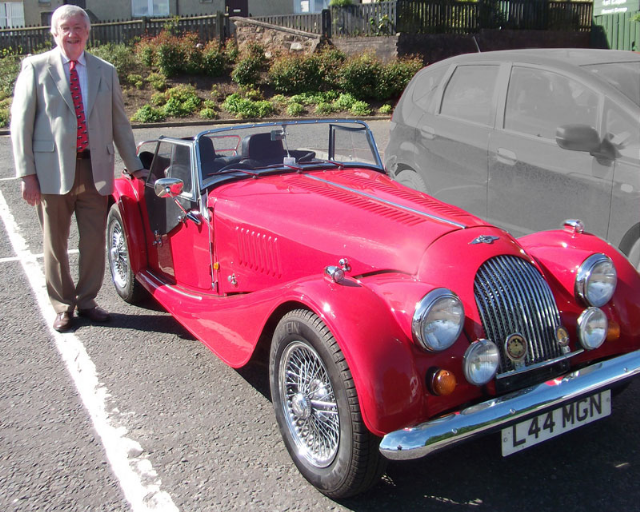
Laurence with his splendid red Morgan in the car park
After questions, Bob Farmer gave a very suitable vote of thanks.
27 May 2015
CHILDREN'S PANEL
Richard Lloyd and Kay Frizell
Our talk today was an explanation of the Children’s Panel and was excellently presented by Richard Lloyd and Kay Frizell.
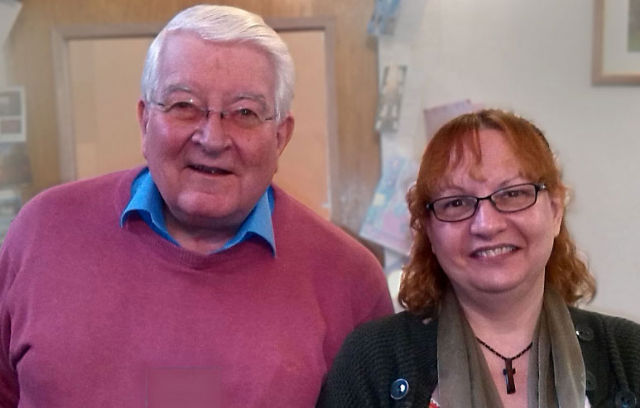
Richard Lloyd and Kay Frizell
With 2500 members across Scotland, this panel exists only in the best interests of the child whether they are offending or offended against.
Kay described her life as a Clinical Psychologist and active member of the Children’s Panel explaining in detail the fundamental principles of their work.
We were left in no doubt as to the power of this organisation and their successes and heard examples of the best, worst and hopeless cases.
The talk demonstrated how rapidly the Panel could act in an emergency, how a Hearing is organised and controlled and the present experiences of poverty within families.
This was a gigantic subject but presented perfectly by Richard Lloyd and Kay Frizell.
After an extremely lively question time Mike Edwards gave the vote of thanks.
>
13 May 2015
STARS OF THE SILVER SCREEN
Andy Paterson
Our speaker today was Andy Paterson, his subject “The Silver Screen” was a very large helping of humour, of interest, of journeys down Memory Lane; indeed a total therapy for a Spring morning.
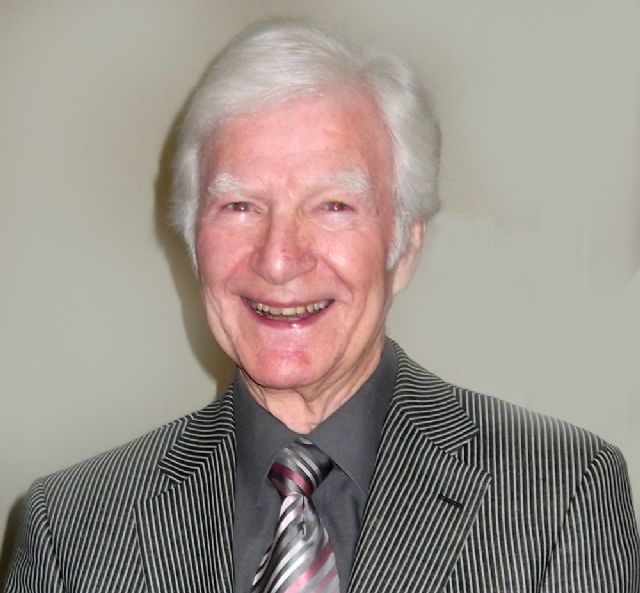
We were blessed with this presentation as we travelled through films on comedy, westerns, musicals and finally cartoons; our memories were stretched to their limit as we were asked to name actors, etc., from the past.
It was slightly disturbing to hear how much knowledge our members could display on actresses and ‘pin-ups’!
Our thanks are extended to Andy for an excellent morning.
Robert McCririck provided the vote of thanks.

22 April 2015
RNLI
Roger Grundy
Today’s speaker, Roger Grundy presented a comprehensive talk on the works of the RNLI around our coastline with particular emphasis on Anstruther.
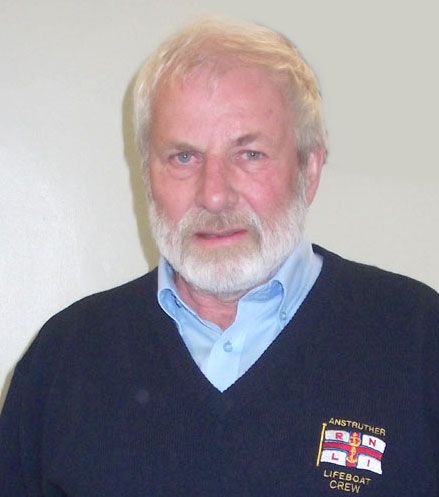
Roger Grundy
This year sees the 150th anniversary of this life boat station and we heard of its achievements and steady progress from men with oars to the first engines in 1933 and on to the latest Mersey Class boat today and the “D” Class Inflatable..
We saw the various methods of launching and recovery showing the determination of lifeboat men going to any length to help seafarers and people in trouble.
The talk included amusing stories and a screened Powerpoint brought this subject to life. Completely dependent on public contributions, Roger Grundy demonstrated reasons for the RNLI being supported and encouraged in their many endeavours and we give our sincere thanks for his presentation.
Anstruther Lifeboat Stationl
Click here for more on our local lifeboat station
8 April 2015
ARTIST AND SCULPTOR
John Bonnington
Our speaker today was John Bonington described as an artist and sculptor.
In telling of his early working life, we quickly became aware of John’s brand of humour and settled down to hear of his time in Warsaw and the strict security.
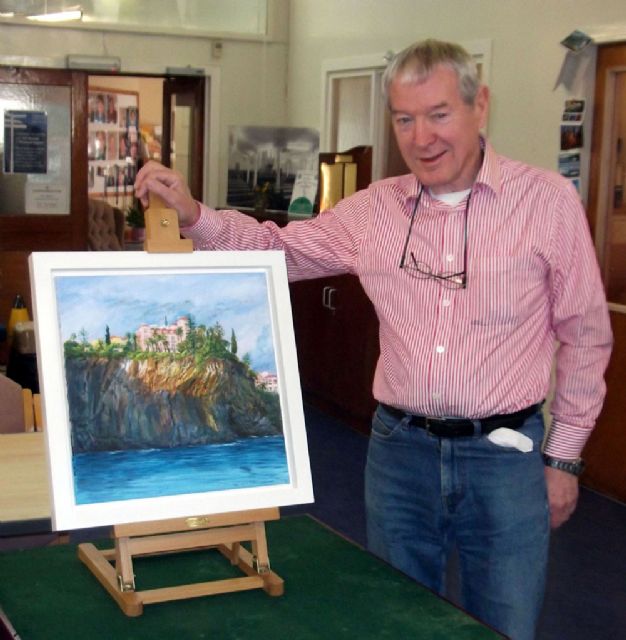
John with an acrylic painting of Reid's Hotel in Funchal
With the assistance of a well prepared slide show we experienced work in various stones, brass, resin-bronze.
Having gone into watercolours we witnessed John’s professional ability with paintings of Dysart, Elie, the Lomonds, St Andrews and others.
After displaying some of his favourite cartoons we heard of the Open Studios Weekend on 2nd, 3rd and 4th May, all details on the John Bonington Facebook or www.openstudiousfife.co.uk
We commend John Bonington on an interesting, humorous presentation. A healthy question time followed and Colin Moore gave a well-deserved vote of thanks.
25 March 2015
JUST A MINUTE
Bert Oliver

50 members gave an enthusiastic welcome to Minute Secretary Bert Oliver whose talk was appropriately entitled “Just a Minute.”
This was a talk covering the history of Cupar Probus minutes from 1987-2000, packed full of interesting snippets.
Comical stories and anecdotes peppered Bert’s well-researched spiel and his pawky humour had the members laughing in appreciation.
We heard about waiting lists for membership, attendances reaching 70 and Probus members being referred to as Elderlies, Whoopies and Wrinklies! Bert also expressed his strong feelings about the importance of keeping the minute books safe and available for future members.
Bert is an accomplished story-teller and is renowned for his humour and timing of punch-lines; he ended by mentioning two members who joined our club the same year his story began (1987), Sam Anderson and Eric Neish, both present today.
We are indebted to Angus Allan for his excellent vote of thanks.
11 March 2015
SKIING IN SCOTLAND
Geoff Armitage
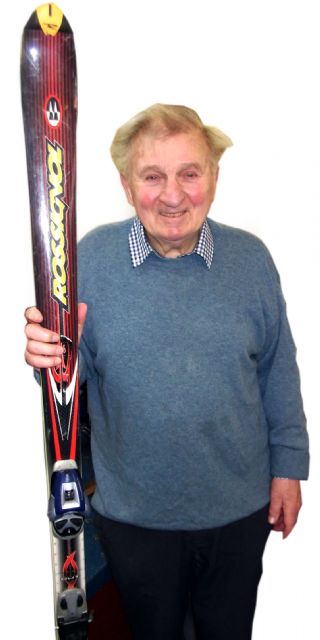
Geoff Armitage presented today’s talk entitled “Skiing in Scotland” and from the earliest known skis made in Norway from birch trees to the latest laminated versions we travelled the snowy tracks of Scotland’s mountains and ski slopes.
We heard how two world wars moved this sport forward via improved clothing and transport.
From home-made skis using Scots pine, Scottish Ski Club, the first Ski School at Dalwhinnie we were led to the first ski lifts and the development of Aviemore as a main centre and onto the latest snowboards.
Geoff ended his talk by describing the future of skiing as questionable because of global warming.
An excellent and interesting talk even for the members who have no wish to rush northwards towards snowy mountains.
Mike Edwards is to be thanked for his assistance in demonstrating a selection of skiing equipment.
Secretary David Galloway offered a vote of thanks.
25 February 2015
THE CALEDON SHIPYARD
John Dein
The subject of today’s speaker was Caledon Shipyard. Dundee and John Dein provided us with a wonderful visual and oral picture of this hard working, successful company.
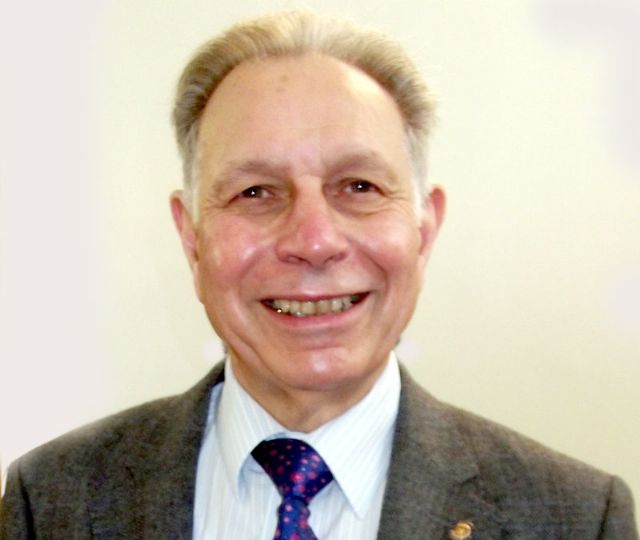
John Dein
John mixed his talk with amusing shipyard stories having begun his career as an apprentice draughtsman. The yard traded for more than a century and successfully launched over 500 ships, the largest being 12000 tons, the company merged with Henry Robb during 1968 and closed in 1981. We witnessed the complete absence of safety procedures as men walked and worked on narrow steel beams with a fall of anything up to 50ft in the event of a wrong move.
With the benefit of old photographs, we visited all the main workshops of this industry as well as the drawing offices and the very beautiful main entrance. The number of questions and observations following John’s talk demonstrated the interest and enjoyment of this subject. Mike Edwards gave a vote of thanks.
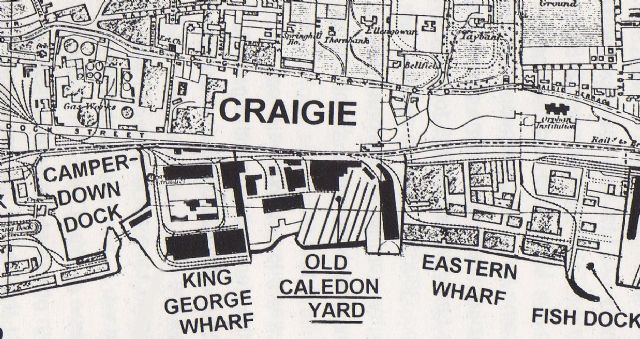
Old Caledon shipyard on the Dundee waterfront (1926 map)
ANTARCTICA
11 February 2015
Our speaker today was Jim Hanson who spoke about an Antarctica cruise.
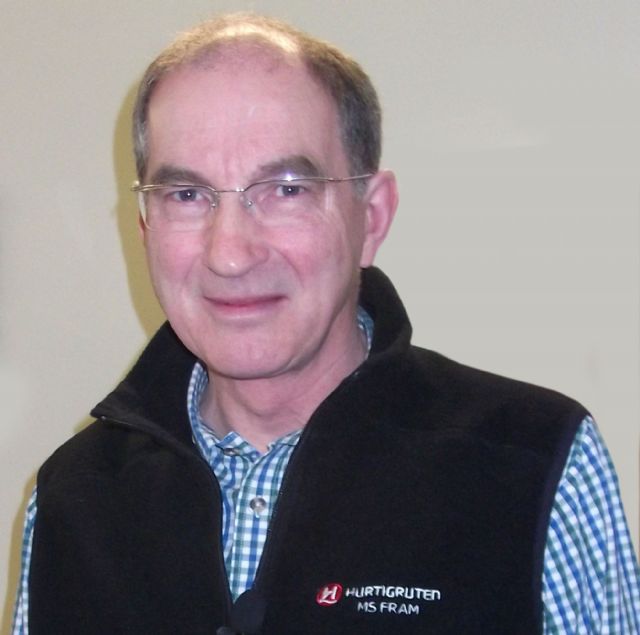
Jim Hanson
This was no ordinary cruise but a voyage of discovery on the MV Fram into this very remote, very dangerous Continent.
All became obvious when Jim described the strict safety precautions, special boots and survival suits. We heard of the professional team of guides and the variety of wild life to be seen.
Penguins, Bull Seals, Whales, Birds, a multitude of icebergs and glaciers all this came to life by the medium of excellent photography. Jim ended by showing the Northern Lights from a previous trip to Norway.
We are grateful to Jim Hanson for his excellent presentation and this was confirmed when Archie Watson gave his vote of thanks on behalf of all members.
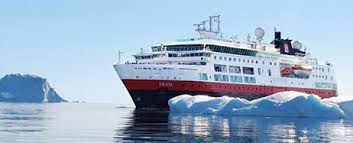
MV Fram
28 January 2015
A BAKER'S DOZEN
Our speaker today was David Galloway, club member and shiny new secretary for 2015, his subject being “A Baker’s Dozen.”
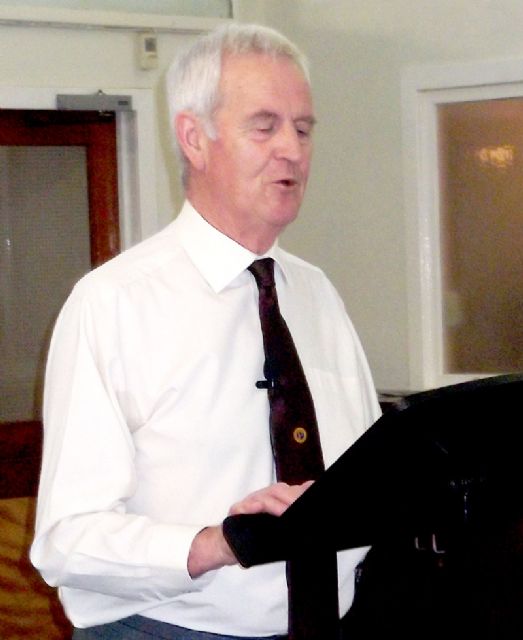
We were treated to David’s collection of poems, stories and jokes covering most aspects of life; Robert Burns, age, sport, religion, animals, war etc.
With his clear speaking voice and easy delivery David brightened up a cold January morning.
Colin Moore gave a well-deserved vote of thanks.
14 January 2015
ANNUAL GENERAL MEETING
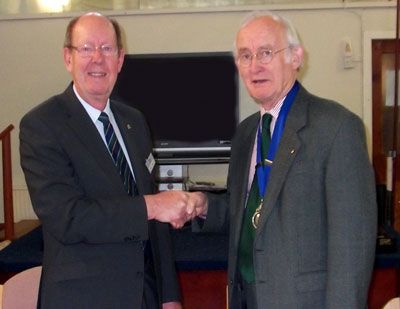
John Topliss (retiring Chairman) inducts David Cleland (right) as the 2015 Chairman
Following the traditional presentation of the Chairman’s Badge of Office and photographs Chairman David Cleland gave his gratitude for this honour and spoke of his hopes for a successful year ahead.
Office Bearers for 2015; Chairman David Cleland, Vice Chairman Bert Oliver, Secretary David Galloway, Treasurer Peter Speirs, Past Chairman John Topliss, Asst Treasurer Ron Campbell, Speakers Team Mike Edwards, David Galloway, Colin Moore, Website Coordinator Maurice Shepherd, Committee Members, John Dewar, Bob Fraser, Keith McIntosh, Robin Thomson, Conveners, Age Concern Alex Ness, Bowls Tom Vickery, Golf Sandy Aitken.
10 December 2014
MINCE PIE DAY

Starring: John Topliss, David Galloway, Ron Campbell and Bert Oliver
As always at our final meeting of the year, we celebrate Mince Pie Day and we looked forward to welcoming the choir of Castlehill Primary School to entertain us with their Christmas programme. However because of the severe weather conditions their visit had to be cancelled.
Following the true traditions of the theatre that the show must go on, four brave lads stepped forward; John Topliss, David Galloway, Ron Campbell and Bert Oliver offered our members poems, stories, jokes and song, all going to end our season on a high note and our thanks to them for their endeavours.
The meeting was closed with Chairman John Topliss wishing Christmas greetings, compliments of the season.
We look forward to meeting again at our AGM on Wednesday 14th January 2015.

26 November 2014
THE COVENANTERS
Edgar Shields
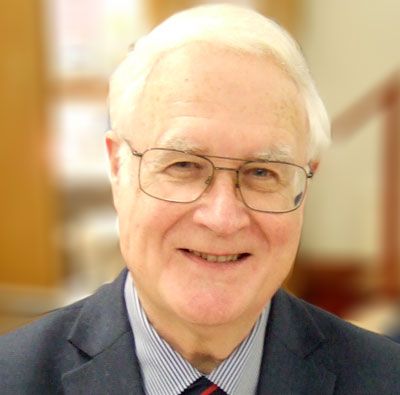
Our speaker today, Edgar Shields presented a talk on The Covenanters.
Edgar is known to us at Cupar Probus Club from at least one previous presentation so we were aware of his excellent speaking voice and brand of humour.
We were led through the very cruel times of the 17th century as our people fought and died for their religious beliefs. Some of us were unaware of the amount of local activity here in Fife and with the aid of screened pictures, we were shown head-stones and memorials in Markinch, St Monans, Leuchars and Cupar etc.
This was a thought-provoking talk from Edgar Shields and one that surely caused some members to question their religious strengths during such a time.
After a busy question time, Mike Edwards gave the vote of thanks.
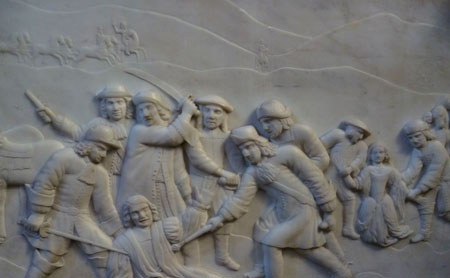
Archbishop Sharp Memorial, St Andrews
12 November 2014
CUPAR IN A BRUSHSTROKE
Isabel Copland
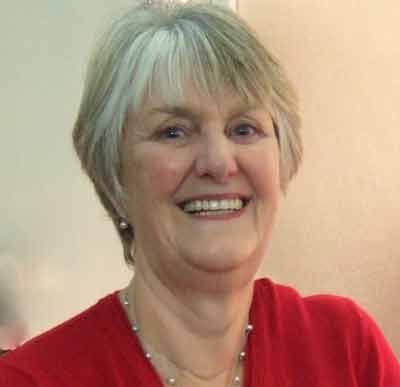
Our talk and painting demonstration today was given by Cupar Art Club President Isabel Copland and was very much ‘a first’ for our Probus Club as we mixed the ancient art of producing a picture with modern technology thereby videoing Isobel as she worked and watching it on our large screen.
The subject was “Cupar in a Brushstroke” and involved bringing an ordinary lane in Cupar to life as we watched.
Isobel talked and answered questions as she worked using pastels.
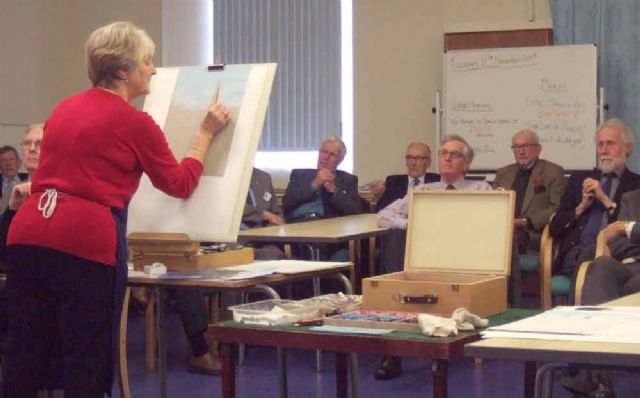
Isabel's drawing is projected onto a screen behind her for all to see.
Our appreciation of this excellent demonstration was recorded by our Vice Chairman David Cleland who also included our technical team for their work in this presentation
22 October 2014
COMPUTERS
John Topliss
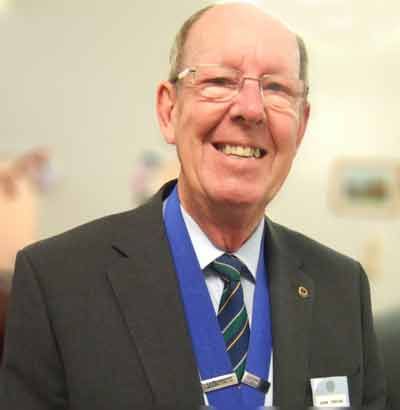
After a hearty introduction by Colin Moore, Chairman John Topliss led us gently through the history of Computers.
He spoke of the years of innovation, development and steadily lowering prices.
We heard of Charles Babbage and his early works, of punch cards, Enigma Code Machines. During the 1960’s when air conditioned, sterile rooms had to be created to take a computer weighing many tons some members showed their age by recalling such times.
Although a very serious subject, Chairman John was able to inject humour and a very realistic American accent where necessary.
The talk ended by bringing us up to date with the latest Tablets, Smart Phones, iPads etc; all this being accompanied by an excellent screen projection adding strength to the talk.
After a busy question time, Malcolm Truesdale gave a vote of thanks.

A Babbage machine
8 October 2014
A VISIT TO CHERNOBYL
Sandy Green
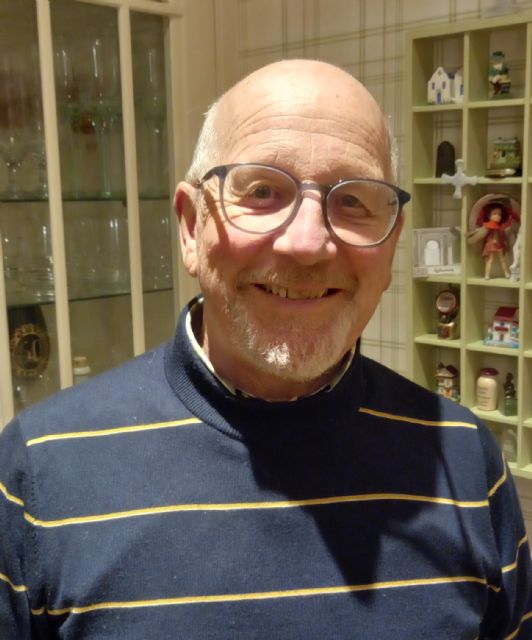
Our talk today was by Sandy Green and was entitled “A visit to Chernobyl” but Sandy quickly explained he was at Belarus, possibly the nearest anyone would wish to be to Chernobyl.
The outward journey in an old single-decked bus was packed with mishaps, wrong turns and ‘Sat-Nav-Sandy’ was blamed for everything!
His talk was filled with humour but in no way hid the dreadful conditions of life in that republic. The aftermath of Chernobyl continues to make its presence felt with children and animals being born with deformities, people in responsible occupations not being paid regularly, etc.
We are very grateful to Sandy Green for this informative talk and after a busy question time, Chairman John Topliss gave a vote of thanks.
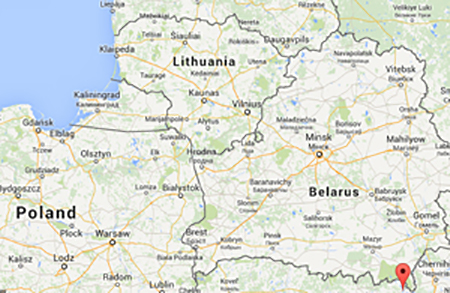
Chernobyl is in the Ukraine - bottom right of the map
24 September 2014
SIR JIMMY SHAND
Ian Thomson
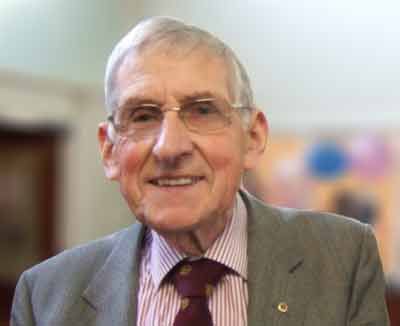
Our speaker today was club member Ian Thomson to speak on the life and times of Sir Jimmy Shand.
Ian spoke of his early attachment to Jimmy Shand and how their friendship flourished; his well-rehearsed presentation carried us through Jimmy Shand’s early beginnings with mouth organ and his drift onto an accordion, times of unemployment, working as a coal miner, his time in the Fire Brigade and his steady rise to world fame with his Shand Morino accordion.
Ian played snippets of music such as “Lunan Bay” “The Bluebell Polka” “Lord and Lady Elgin” finishing with Ian’s own accolade “Supt Ian Thomson’s farewell tae the Fife Police!”
Sir Jimmy was a stalwart and enthusiastic member of Cupar Probus Club and Ian Thomson must be thanked for his excellent talk and for keeping the memory of Jimmy Shand alive as he continues to give his talk to clubs and organisations when called upon.
After questions, Mike Edwards gave a vote of thanks.
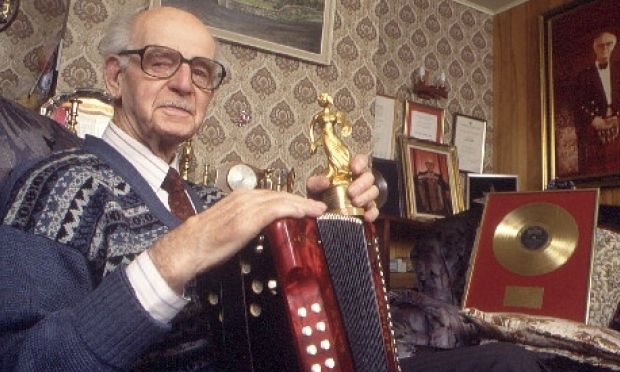
Sir Jimmy Shand
10 September 2014
THE GOLFING KYLES
Eve Soulsby
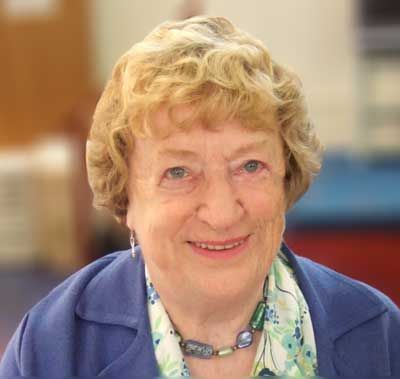
Our speaker today was Mrs Eve Soulsby with the history of the Kyle family.
During the early-to-mid 1900’s this family of three boys and three girls matured to excel in sport and academic studies.
They all became expert golfers, the boys taking part in many other sports; their schooling did not take second place as sometimes happens and they all achieved professional careers.
It was also nice to hear that the family achieved longevity, the men reaching their 80’s and the ladies their 90’s.
Eve Soulsby presented her talk in a homely manner liberally scattered with a quiet humour and although mainly concerned with golfing achievements, non-golfers were surely intrigued by the subject.
After questions, David Galloway provided a suitable vote of thanks.
27 August 2014
FORTH ROAD CROSSINGS
Bob Hamilton

In a change to the advertised programme, our speaker today was Bob Hamilton from Dunfermline Probus Club who would present financial aspects of the new Forth Road Bridge, (The Queensferry Crossing).
At the moment, believed to be the costliest bridge in the world at £1.45b Bob compared it with similar structures, including higher and longer bridges all costing much less.
We heard of other building works where costs spiralled out of all relation to original estimates; Holyrood, Skye Crossing, Edinburgh Infirmary and Edinburgh Tramcar System.
The difference in costs between commencing and completing structures was, without exception mind-blowing.
To be expected, question time was extremely busy and reflected our appreciation of a well-researched and presented talk.
Ron Campbell recorded our thoughts in his vote of thanks.
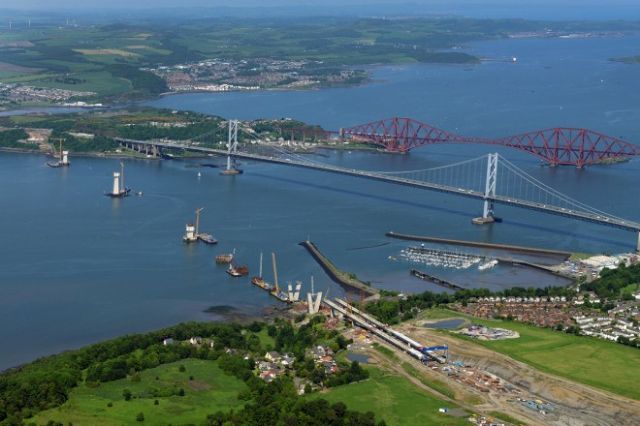 >
>Three crossings
13 August 2014
A LOT OF HOT AIR
Ian Gilchrist
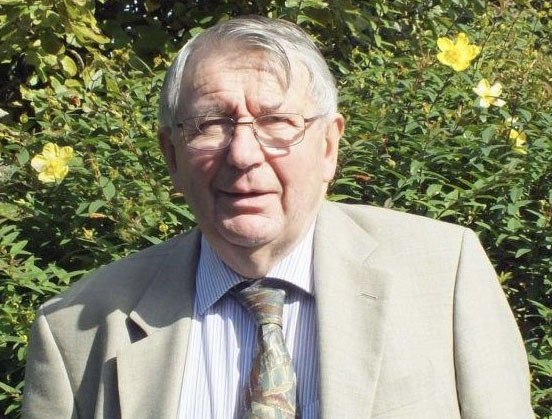
Today we enjoyed a clever PowerPoint presentation from Ian Gilchrist on hot-air balloons.
We travelled in time to the 18th century when by accident it was discovered that heat would cause an object to rise.
From such early beginnings we were flown through various types of balloons and heating systems finally arriving at today’s easily recognised versions and varieties.
This well prepared presentation culminated in a filmed flight from Penicuik to Carlops. Our sincere thanks go to Ian Gilchrist for allowing us to view areas of Scotland from a height of 2000 ft.
After questions, Bob Hopkins gave a vote of thanks.
Hot air balloon over Loch Leven
23 July 2014
ROBINSON CRUSOE
Daniel Caldwell

Entitled “Robinson Crusoe,” our talk today was given by David Caldwell and was the story of Alexander Selkirk and his four years on the island of Juan Fernandez after being abandoned by the his ship.
We heard of the Selkirk family and their wayward lifestyle, Alexander going to sea and his many adventures including piracy.
Because David Caldwell has visited the island, his talk became very real as he related his researches. An abundance of goat meat, fruit, fish and water makes this an easy place to be abandoned; it was renamed Robinson Crusoe Island by the Chilean Government in 1966, and lies 360 miles off the Chilean coast.
This was the adventure to inspire Daniel Defoe to write his “Robinson Crusoe” novel. An excellent story and presentation from David Caldwell with several questions to follow.
Bert Oliver gave a vote of thanks.

Juan Fernandez island
9 July 2014
BREWING IN FIFE
John Reade
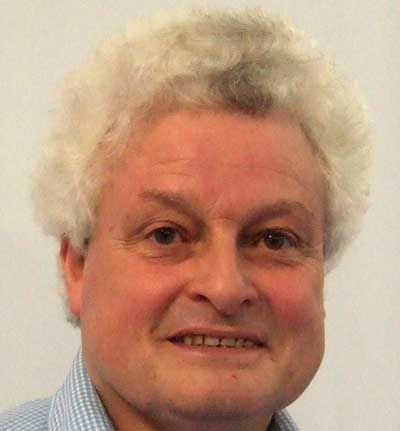
Our speaker today, John Reade spoke on ‘Brewing in Fife’ but mainly in and around the Cupar area.
John travelled back in time to the mid-18th century when beer was consumed throughout the day.
This was obviously John’s subject as he compared the multitude of small breweries and how the same system is used today but with modern equipment.
Of particular interest were the street maps of Cupar showing where breweries were located. John runs his own brewery at Abbot House Heritage Centre, Dunfermline where visitors are welcome by appointment.
A most interesting presentation and a suitable vote of thanks by Robert McCririck.
Click here for information about our local Eden Brewery
25 June 2014
POETRY & MUSIC
Bert Oliver and George Wilson
At very short notice, Club Members, Bert Oliver with poems and prose and George Wilson on accordion stepped in this morning to fill an unexpected vacancy and provided a good measure of words and music to a very appreciative audience.
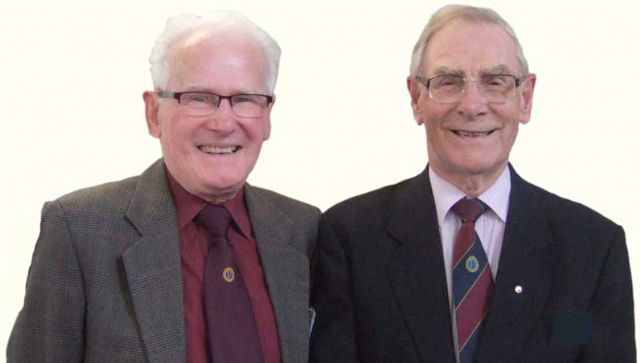
Bert Oliver and George Wilson
George played such toe-tappers as Farewell to Uist, Dumbarton Castle, Loch Maree Islands, The Marquis of Tullibarton and several more while Bert recited poetic treasures such as The Guide Scotch Pie, No medal at the Mod, Glasgow Love Poem, Granny’s Porridge among others.
The presentation was very well received and Archie Watson gave a vote of thanks.
11 June 2014
LIFE IN SOUTH AFRICA
Jan Steyn
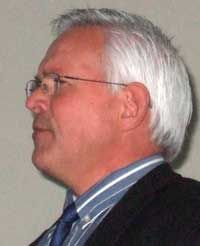
“Life in South Africa” was Rev Jan Steyn’s chosen subject and we were immediately made aware of Jan’s enthusiasm and vigour for his birthplace.
In a presentation controlled only by time, Jan was able to transmit a full picture of animals, birds, the geography and the sheer size of his country.
We heard of the very sad times followed by the changing scene as the years and people changed. He spoke fondly of Nelson Mandella and his great works.
It was fitting that we had a record number of members present today to hear and enjoy this superb talk by Rev Jan Steyn.
After several questions Bob Farmer offered an excellent vote of thanks.
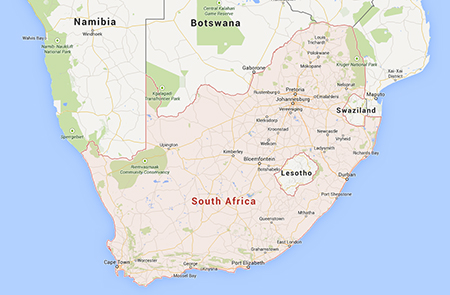
South Africa
28 May 2014
VICTORIAN POSTCARDS
David Fraser
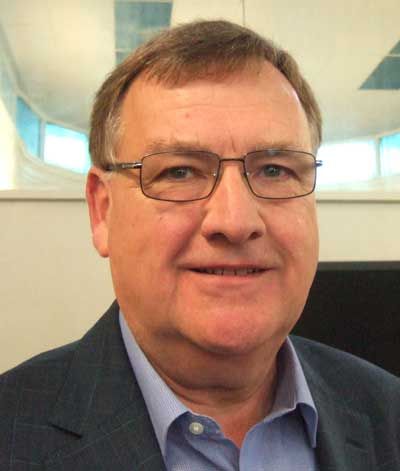
David Fraser was today’s speaker and his subject was “The Postcard Century.”
The study of postcards, (deltiology) came alive as David described how they were used as a means of communication in times past and now replaced by text, email etc.
With a collection of 1500 postcards containing several complete sets on a particular subject we were made aware of the information to be gained from a simple postcard.
The use of screen and projector added even more interest to this presentation.
Bob Farmer gave a well-deserved vote of thanks.
Click here to see the many postcards published by Raphael Tuck & Sons
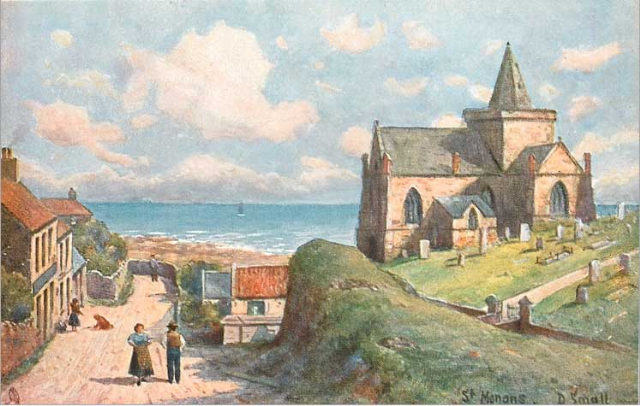
Postcard of St Monans
14 May 2014
THE BREWSTER BUFFALO
Ron Campbell

Today’s speaker was club member Ron Campbell.
His subject was “The Brewster Buffalo.” After some of us were made aware we were not bound for the great prairies of America but to WW2 and the American built Brewster Buffalo fighter aircraft, Ron displayed his extensive knowledge of aircraft during times of war.
We heard of the history of this fighter craft, its development and the difficult way it was manufactured in a most unsuitable building. The Brewster Buffalo (F2A) earned the title of the worst fighter aircraft in the world and “The Flying Coffin”.

A Brewster F2A-3
Ron Campbell spoke freely and easily on his subject and is to be commended on his research.
Bob Fraser gave the vote of thanks.
Click here for more information on the Brewster Buffalo
v
23 April 2014
POLISH TROOPS IN SCOTLAND
Eduard Klak
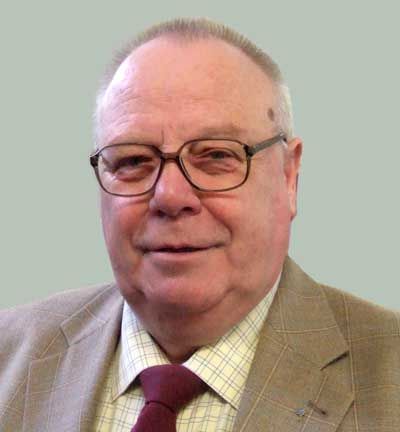
‘Polish troops in Scotland’ was the subject and Eduard Klak was our presenter.
With the aid of projector and screen Eduard gave a full history of Poland and its constant battles with Germany and Russia stretching back into the 1500’s: he highlighted the constantly moving border as each country fought for land.
We moved through the strong alliance between Scotland, France and Poland covering all aspects of politics and religion.
Eduard reflected on WW2 and spoke of his father’s war history. We record our thanks to Eduard Klak for his efforts.
Treasurer Peter Spiers gave a vote of thanks.
9 April 2014
KLONDIKE GOLD RUSH
Martin Hepworth

We welcomed the ‘weel-kent’ face of Dr Martin Hepworth today to speak on the Klondike Gold Rush.
Martin spoke easily on this subject for 60 minutes providing us with facts, figures and a frightening picture of thousands of men and their vain attempts to reach the goldfields.
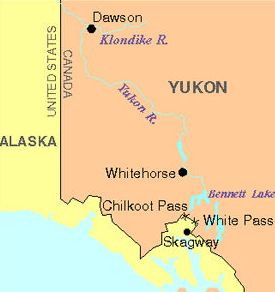
With the use of excellent photographs, old and new we were made aware of the sheer size of the area, how thousands of men left home totally unprepared for what lay ahead. We heard of the first strike, we heard of the policing part played by Royal Canadian Mounted Police.
What can only be described as sheer madness and lust for gold was brought to life for the members of Cupar Probus Club and we are extremely grateful to Dr Martin for his presentation.
Prof John McManus gave a well-deserved vote of thanks.
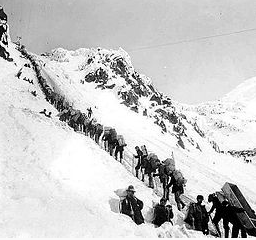
Setting off up the Chilkoot Pass
Click here for more information
26 March 2014
FARMING IN YESTERYEAR
Andrew Arbuckle
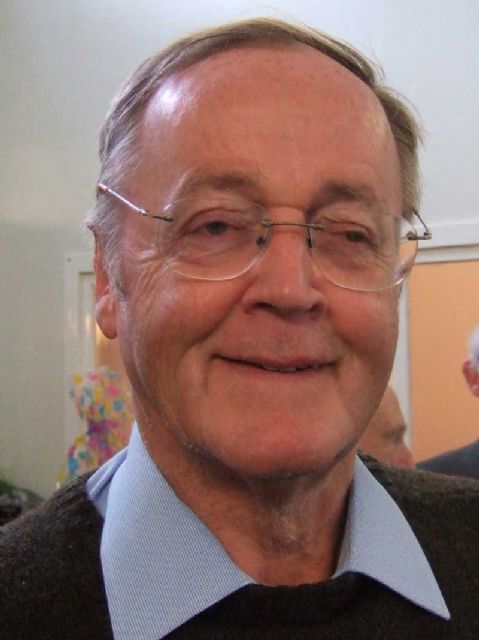
With the title “Farming in Yesterday,” the members of this club knew we were travelling down memory lane, (or farm track) led by Andrew Arbuckle.
Andrew began by touring Cupar, the market/farming town of this area.
We heard how dealing and trade was done in the Crossgate, described the normal layout of the Corn Exchange. We experienced feeing days when farm hands moved on, not only the problems but also opportunities to be gained by a good move.
Moving on to the town’s Beet Factory when it opened during the 1920s and the very successful Stallion Shows in the Cart Haugh.
Prior to the tractor, the Clydesdale horse reigned supreme. The coming of the railways opened a new world for farmers allowing them to transport cattle and produce across a much wider area.
Our eyes were opened to the steadings, the farmhouses and the strict ‘pecking order’ of farm hands. Within the time available, Andrew Arbuckle ploughed in a comprehensive picture of farming life at all levels and he is to be congratulated on his inspiring presentation.
Andrew has published three books on this subject. “Footsteps in the Furrow,” “We waved to the Baker” and “The first 100 years.”
After a busy question time, Sandy Wynd gave a vote of thanks.
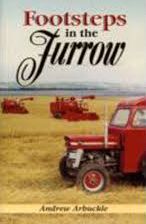
by Andrew Arbuckle
12 March 2014
THE "COONCIL SPEKE"
Bill Ritchie
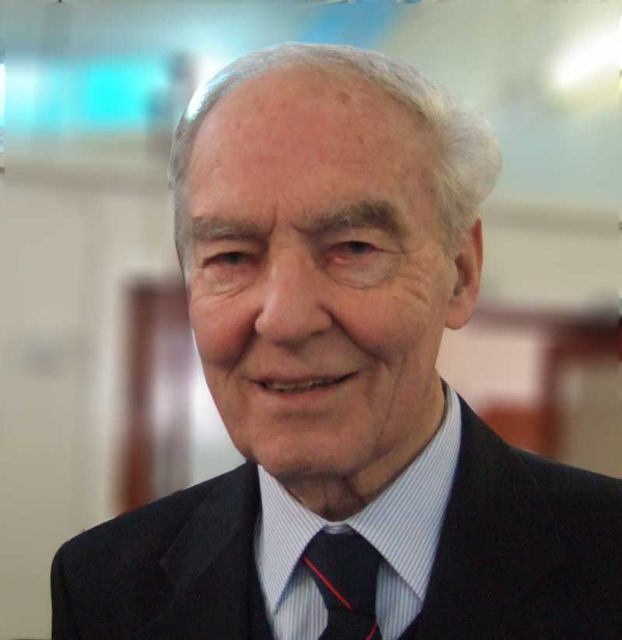
Our speaker today, Bill Ritchie spoke on the subject of “The Cooncil Speke”. Bill began by outlining his life in education and his work on various committees that gave him contact with councillors.
He spoke of his interests in golf and music and likened the arm action with his violin not unlike that of his golf swing.
We heard quotes from three main areas, Council meetings, football managers and children.
The wee lad at Sunday school with very shiny shoes because of his slight misunderstanding of the children’s hymn “Jesus bids us shine,” the football manager who said “My team has it’s 2nd Leg up it’s sleeve,” the councillor who said he could half the problem by 75% and “I want quarterly meetings twice a year!”
Bill Ritchie presented his talk in an easy, relaxed manner and several personal examples were recounted by our members.
Ian Thomson gave a vote of thanks.
26 February 2014
CUPAR OLD CHURCH
David Cleland
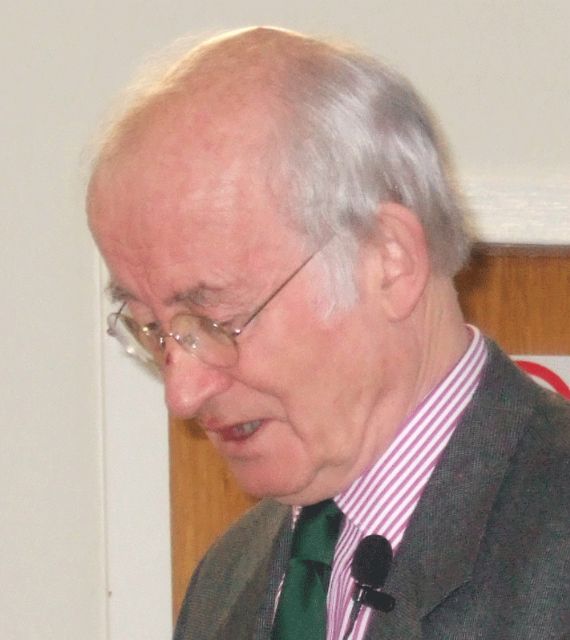
Colin Moore introduced our speaker today, who by coincidence was David Cleland, his subject being Cupar Old Church. David has made a study of this 600 year-old church but was today concentrating on 23 years during the 19th century, (1838-61).
We heard extracts from the first Minute and information on the first Church in Cupar, a very destructive fire circa 1412 and a description of life and times in the early 1800’s, listing the various trades and the positions held within Cupar Old Church.
David described the power of the Church as they sat in judgement of sinners and people who strayed from righteousness, we also heard of The Disruption of 1843, when a large number of ministers left to form the Free Church of Scotland.
This was a very large subject but our speaker kept it in his control. David Cleland is to be congratulated on leading us as Chairman; advising us as Secretary and enlightening us as today’s speaker. Angus Allan gave the vote of thanks.
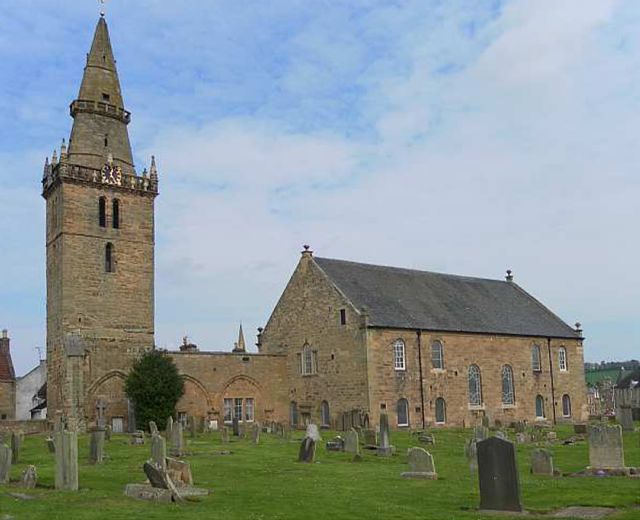
Cupar Old Church (© Martin Baird)
12 February 2014
BOWEL CANCER
Glenys Marra
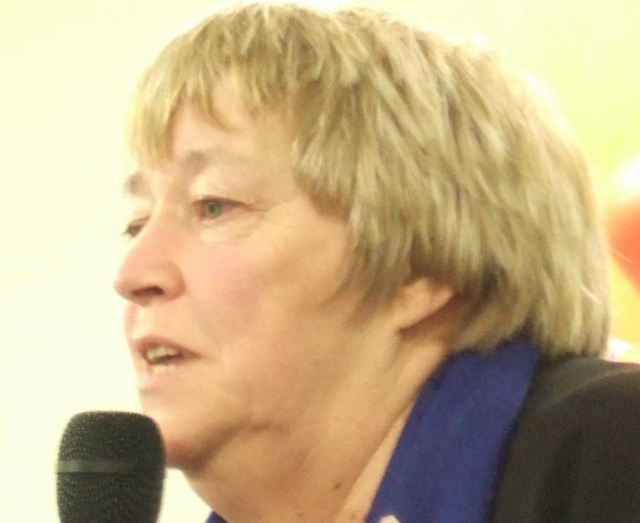
Our speaker today was Glenys Marra on the subject of Bowel Cancer. This was a difficult and sensitive subject but Glenys spoke easily after explaining she was not medically trained but had suffered from this illness and received corrective surgery.
She spoke highly of surgeons, doctors and care nurses during her ongoing treatment and went on to describe good and poor foods and lifestyles to help keep this area of our bodies as healthy as possible.
Glenys Marra must be complemented on her presentation and the volume of questions demonstrated our interest in the subject.
Colin More gave an excellent vote of thanks.
22 January 2014
ROBERT BURNS
Bob Drummond & Alastair McFarlane
Our talk today was headed “Robert Burns” by Bob Drummond with Alistair McFarlane on violin but nothing can do justice to this superb presentation by the two men.
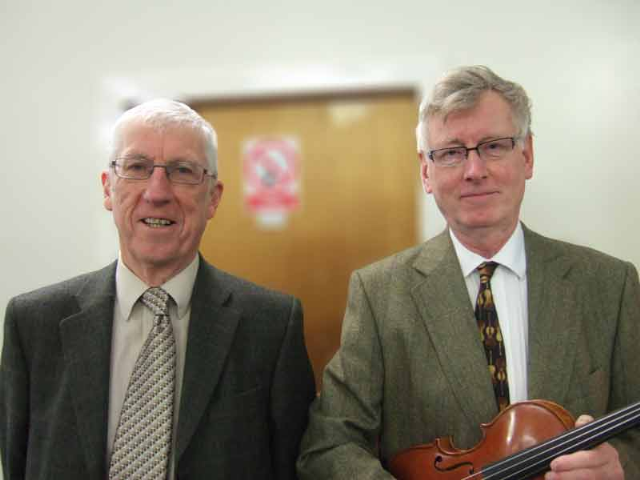
Bob Drummond and Alistair McFarlane
In words, songs and music, mixed heavily with couthie humour we were led through the life and loves of our Bard. Bob Drummond related the story of Robert Burns with great feeling and the music and song provided by Alistair made this day an excellent beginning to our new year at Cupar Probus Club.
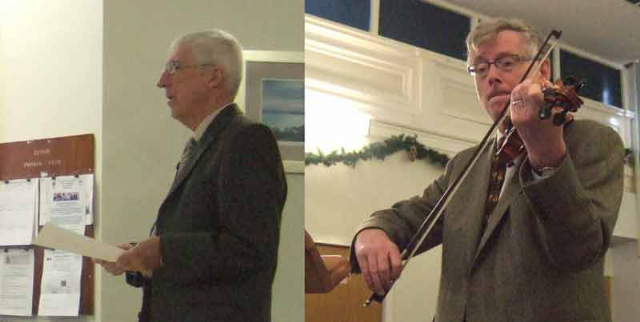
Words and Music
David Galloway’s vote of thanks, given as a play on the words of Burns’ “Is there for honest poverty?” was the icing on the cake and a perfect end to a perfect morning.
